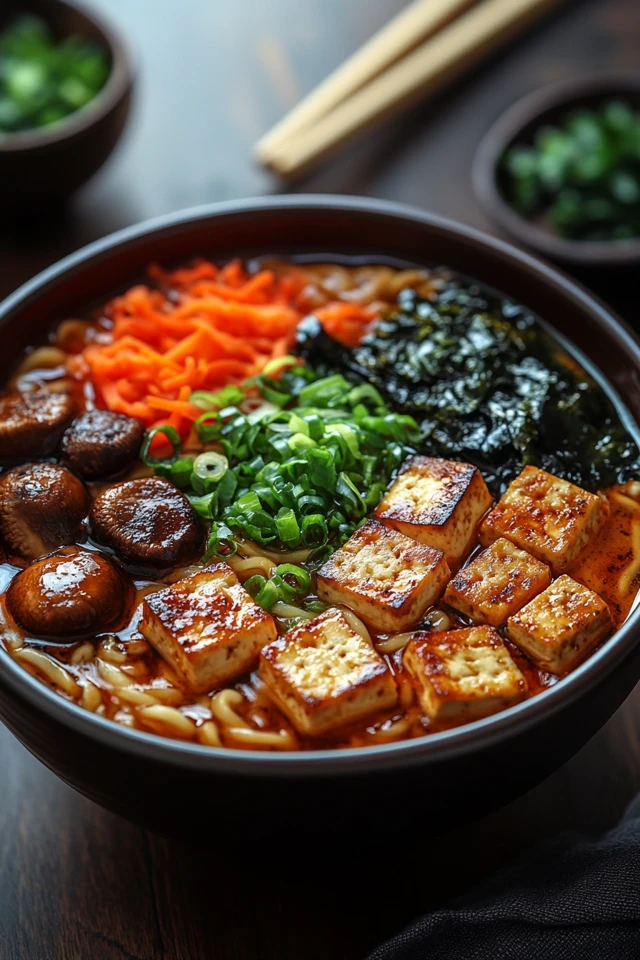Introduction
Dive into the soothing and savory world of Japanese Vegan Ramen: Comforting & Flavorful Bowl! This exquisite vegan take on a beloved Japanese classic combines rich, umami-packed broth with tender noodles, fresh vegetables, and hearty plant-based proteins, creating a harmonious and satisfying meal that warms both the body and soul. Perfect for chilly evenings, busy weeknights, or whenever you crave a nourishing and delicious bowl of goodness, this vegan ramen is sure to become a staple in your culinary repertoire.
Ramen, a cornerstone of Japanese cuisine, is renowned for its depth of flavors and comforting qualities. Our vegan version captures the essence of traditional ramen by utilizing plant-based ingredients that deliver authentic taste and texture without compromising on health or ethical values. Whether you’re a seasoned vegan or simply looking to incorporate more plant-based meals into your diet, this Japanese Vegan Ramen offers a delightful blend of flavors and nutrients that cater to all palates. In this comprehensive guide, we’ll explore the benefits of vegan ramen, provide a detailed recipe, and share tips and variations to customize it to your liking. Let’s embark on a culinary journey to create a comforting and flavorful vegan Japanese ramen bowl that will delight your taste buds and nourish your body!
Why Choose Japanese Vegan Ramen?
Opting for Japanese Vegan Ramen offers a multitude of benefits that cater to health, ethical, and culinary preferences. Here’s why this dish should become a staple in your meal planning:
Health-Conscious Choice
- Nutrient-Rich: Packed with fresh vegetables, plant-based proteins, and a savory broth, this ramen provides a balanced mix of vitamins, minerals, and antioxidants essential for overall health.
- Heart-Healthy Fats: Using sesame oil and plant-based broth introduces heart-healthy monounsaturated and polyunsaturated fats, promoting cardiovascular health and satiety.
- High in Fiber: Whole-grain noodles and an abundance of vegetables contribute to a high fiber content, aiding in digestion and promoting sustained energy levels.
- Low in Saturated Fats: By replacing traditional animal-based broths and proteins with plant-based alternatives, this ramen reduces saturated fat intake, supporting heart health.
Ethical and Sustainable
- Plant-Based: Embracing a plant-based meal reduces your carbon footprint and supports sustainable eating practices, benefiting both your health and the environment.
- Cruelty-Free: Free from animal products, this ramen aligns with compassionate lifestyle choices and ethical food preferences.
Versatile and Customizable
- Flavor Adjustments: Easily tweak the seasoning and ingredients to suit your taste preferences, whether you prefer a spicier kick or a more umami-rich profile.
- Ingredient Flexibility: Substitute or add various vegetables, proteins, or herbs based on availability and personal preferences, making the recipe adaptable to various dietary needs.
- Serving Options: Serve as a standalone meal, alongside other Japanese-inspired dishes, or as part of a larger meal spread for added variety and balance.
Delicious and Satisfying
- Balanced Flavors: The combination of rich broth, tender noodles, fresh vegetables, and hearty protein creates a balanced and satisfying flavor profile that delights the palate.
- Elegant Presentation: A well-prepared ramen bowl not only tastes amazing but also looks visually appealing, making it perfect for both everyday meals and special occasions.
Ingredients
Creating Japanese Vegan Ramen involves a harmonious blend of savory broth, tender noodles, fresh vegetables, and flavorful toppings. Here’s what you’ll need:
For the Broth
- Vegetable Broth: 6 cups (low-sodium preferred)
- Soy Sauce or Tamari: 3 tablespoons (for gluten-free)
- Miso Paste: 2 tablespoons (white or yellow for a milder flavor)
- Sesame Oil: 2 teaspoons
- Garlic Cloves: 4, minced
- Ginger: 2 tablespoons, freshly grated
- Shiitake Mushrooms: 4, sliced (fresh or dried)
- Star Anise: 2 whole
- Cinnamon Stick: 1
- Water: 2 cups (for soaking dried mushrooms if using)
For the Ramen
- Ramen Noodles: 12 ounces (choose wheat or gluten-free based on preference)
- Tofu: 1 block (14 oz), pressed and cubed (or substitute with tempeh or seitan)
- Spinach or Bok Choy: 4 cups, fresh
- Carrots: 2 large, julienned
- Corn Kernels: 1 cup (fresh or frozen)
- Green Onions: 4, sliced
- Nori Sheets: 2, cut into strips (optional)
- Sesame Seeds: 2 tablespoons, toasted
For the Tofu Marinade (Optional)
- Soy Sauce or Tamari: 2 tablespoons
- Maple Syrup or Agave Nectar: 1 tablespoon
- Rice Vinegar: 1 tablespoon
- Garlic Powder: 1 teaspoon
- Smoked Paprika: 1/2 teaspoon
Optional Add-ins and Toppings
- Bean Sprouts: 1 cup, fresh
- Bamboo Shoots: 1/2 cup, sliced
- Cornichons or Pickled Ginger: For a tangy contrast
- Chili Oil or Sriracha: For added heat
- Vegan Chili Crisp: For a crunchy spicy topping
Ingredient Breakdown
- Vegetable Broth: Forms the rich and flavorful base of the ramen, providing depth and umami.
- Miso Paste and Soy Sauce: Enhance the broth with savory and salty notes, adding complexity to the flavor profile.
- Sesame Oil, Garlic, and Ginger: Infuse the broth with aromatic and robust flavors that elevate the overall taste.
- Shiitake Mushrooms, Star Anise, and Cinnamon Stick: Contribute earthy and warm spices that deepen the broth’s flavor.
- Ramen Noodles: Serve as the hearty and satisfying component that holds the broth and toppings together.
- Tofu, Spinach, Carrots, and Corn: Provide a balanced mix of protein, vitamins, minerals, and textures, making the dish nutritious and filling.
- Green Onions, Nori Sheets, and Sesame Seeds: Add freshness, umami, and a touch of elegance to the final presentation.
Instructions
Preparing Japanese Vegan Ramen is straightforward and yields a delicious, nutritious meal perfect for any occasion. Follow these step-by-step instructions to create a comforting and flavorful vegan ramen bowl in about 1 hour and 30 minutes.
Step 1: Prepare the Broth
- Soak Dried Mushrooms (if using):
- If using dried shiitake mushrooms, place them in a bowl with 2 cups of hot water. Let them soak for 20 minutes until rehydrated. Remove and slice the mushrooms, reserving the soaking water.
- Sauté Aromatics:
- In a large pot, heat 2 teaspoons of sesame oil over medium heat.
- Add the minced garlic and grated ginger, sautéing for 2-3 minutes until fragrant.
- Add Mushrooms and Spices:
- Stir in the sliced shiitake mushrooms (fresh or rehydrated).
- Add the star anise and cinnamon stick, cooking for another minute to release their flavors.
- Combine Broth Ingredients:
- Pour in 6 cups of vegetable broth and the reserved mushroom soaking water (if using dried mushrooms).
- Stir in 3 tablespoons of soy sauce or tamari and 2 tablespoons of miso paste until well combined.
- Simmer the Broth:
- Bring the mixture to a gentle boil, then reduce the heat and let it simmer for 25-30 minutes to allow the flavors to meld together.
- Strain the Broth:
- Remove the star anise and cinnamon stick.
- If desired, strain the broth through a fine-mesh sieve to remove any solids for a smoother texture. Return the broth to the pot and keep warm.
Step 2: Marinate and Cook the Tofu (Optional)
- Prepare the Marinade:
- In a shallow dish, combine 2 tablespoons of soy sauce or tamari, 1 tablespoon of maple syrup or agave nectar, 1 tablespoon of rice vinegar, 1 teaspoon of garlic powder, and 1/2 teaspoon of smoked paprika.
- Marinate the Tofu:
- Add the pressed and cubed tofu to the marinade, ensuring each piece is well-coated.
- Let it sit for at least 15 minutes, turning occasionally to absorb the flavors.
- Cook the Tofu:
- Heat a non-stick skillet over medium-high heat.
- Add a splash of oil and sauté the marinated tofu cubes until golden brown on all sides, about 5-7 minutes. Set aside.
Step 3: Cook the Ramen Noodles
- Boil the Noodles:
- In a separate large pot, bring water to a boil. Add a pinch of salt.
- Cook 12 ounces of ramen noodles according to the package instructions until al dente, usually about 4-5 minutes.
- Drain and Rinse:
- Drain the noodles and rinse them under cold water to stop the cooking process. Set aside.
Step 4: Prepare the Vegetables
- Slice the Vegetables:
- Julienne the carrots and slice the bell peppers into thin strips.
- Halve the cherry tomatoes if using.
- Sauté Spinach or Bok Choy:
- In a small pan, heat a teaspoon of sesame oil over medium heat.
- Add the chopped spinach or bok choy, sautéing for 2-3 minutes until wilted. Set aside.
Step 5: Assemble the Ramen Bowls
- Combine Broth and Noodles:
- Divide the cooked ramen noodles evenly among 6 bowls.
- Ladle the hot broth over the noodles, ensuring each bowl has a good amount of liquid.
- Add Toppings:
- Arrange the sautéed spinach or bok choy, julienned carrots, sliced bell peppers, and corn kernels on top of the noodles.
- Add the sautéed tofu cubes (or your chosen protein) for a hearty addition.
- Sprinkle with fresh green onions, toasted sesame seeds, and nori strips if using.
- Garnish and Serve:
- Garnish each bowl with a squeeze of fresh lime juice for brightness.
- Optionally, add avocado slices or a drizzle of chili oil for extra richness and heat.
- Enjoy:
- Serve the Japanese Vegan Ramen hot and enjoy the comforting and flavorful combination of ingredients.
Tips and Variations
Enhance your Japanese Vegan Ramen with these helpful tips and creative variations:
1. Customize the Broth
- Shoyu Ramen: Add more soy sauce for a saltier, more savory broth.
- Miso Ramen: Increase the amount of miso paste for a deeper umami flavor.
2. Experiment with Different Proteins
- Tempeh: Substitute tofu with tempeh for a nuttier flavor and firmer texture.
- Seitan: Use seitan for a chewy and protein-rich alternative.
- Edamame: Add shelled edamame for an extra protein boost and vibrant color.
3. Incorporate More Vegetables
- Baby Bok Choy: Use baby bok choy for a tender and mild flavor.
- Corn and Bean Sprouts: Add bean sprouts for crunch and additional fiber.
- Mushrooms: Incorporate a variety of mushrooms like enoki or oyster for diverse textures.
4. Add a Spicy Kick
- Chili Oil: Drizzle chili oil over the ramen for added heat.
- Sriracha: Add a dollop of sriracha or your favorite hot sauce to taste.
- Fresh Chilies: Slice fresh jalapeños or serrano peppers and add them as toppings.
5. Enhance the Umami
- Nutritional Yeast: Sprinkle extra nutritional yeast for a cheesier, umami flavor.
- Seaweed: Add more nori or incorporate kombu into the broth for deeper umami notes.
6. Make It Creamier
- Coconut Cream: Stir in a splash of coconut cream for an extra creamy texture.
- Cashew Cream: Blend soaked cashews with water and add to the broth for a rich, dairy-free creaminess.
7. Serve with Sides
- Gyoza: Pair the ramen with vegan gyoza for a complete meal.
- Japanese Pickles: Serve alongside pickled vegetables like takuan or kimchi for a tangy contrast.
8. Enhance Presentation
- Layered Bowls: Arrange toppings in separate sections for a visually appealing layered effect.
- Individual Garnishes: Provide individual garnishes like lime wedges and extra green onions for personalized flavor adjustments.
9. Make It Ahead
- Prep Ingredients: Prepare and chop all vegetables and proteins ahead of time to streamline the assembly process.
- Store Broth Separately: Store the broth and toppings separately in the refrigerator to maintain freshness and texture.
10. Create a Themed Ramen
- Spicy Miso Ramen: Combine miso paste with extra spices for a spicy miso ramen.
- Vegetarian Tonkotsu Ramen: Use a creamy, plant-based broth inspired by traditional tonkotsu ramen for a rich and hearty flavor.
Nutritional Information
Understanding the nutritional profile of your meals helps you make informed dietary choices. Here’s the approximate nutritional breakdown for one serving of the Japanese Vegan Ramen (serves 6):
Per Serving:
- Calories: 500 kcal
- Protein: 18g
- Carbohydrates: 60g
- Fiber: 8g
- Fat: 20g
- Saturated Fat: 7g
- Sugar: 6g
- Sodium: 1000mg
Nutritional Highlights:
- High in Protein and Fiber: Tofu and vegetables provide a substantial protein and fiber boost, promoting muscle maintenance and digestive health.
- Healthy Fats: Sesame oil and plant-based broth contribute heart-healthy monounsaturated and polyunsaturated fats essential for cardiovascular health and satiety.
- Vitamins and Minerals: A variety of vegetables supply vitamins A and C, potassium, iron, and magnesium, supporting various bodily functions.
- Antioxidants: Ingredients like garlic, ginger, and fresh herbs are loaded with antioxidants that combat oxidative stress and support immune function.
Adjusting Nutritional Content:
- Lowering Calories: Reduce the amount of sesame oil used or opt for a spray oil to minimize fat content. Incorporate more low-calorie vegetables like broccoli or mushrooms for added volume without extra calories.
- Increasing Protein: Add more tofu or incorporate additional protein-rich ingredients like edamame or chickpeas into the ramen.
- Reducing Sodium: Use low-sodium soy sauce or tamari and adjust the added salt based on your dietary needs. Incorporate more herbs and spices to enhance flavor without relying solely on salt.
Conclusion
The Japanese Vegan Ramen: Comforting & Flavorful Bowl is a perfect blend of health-conscious ingredients and bold, satisfying flavors, making it an ideal addition to any meal plan. This dish not only caters to vegan and gluten-free dietary needs but also provides a wholesome and flavorful option that supports your health and well-being.
Whether you’re preparing a family dinner, hosting a festive party, or looking for a nutritious and elegant meal, this vegan ramen offers versatility, ease of preparation, and endless customization options to suit your preferences. Embrace the rich, umami flavors of Japanese cuisine with the comforting warmth of a steaming ramen bowl in this delightful recipe that celebrates the best of wholesome and flavorful plant-based cooking.
Enjoy the process of simmering, assembling, and savoring your ramen, and relish each bite knowing you’re nourishing your body with wholesome, plant-based goodness. Here’s to creating and enjoying meals that bring joy, health, and a touch of elegance to your table!
Picture Gallery
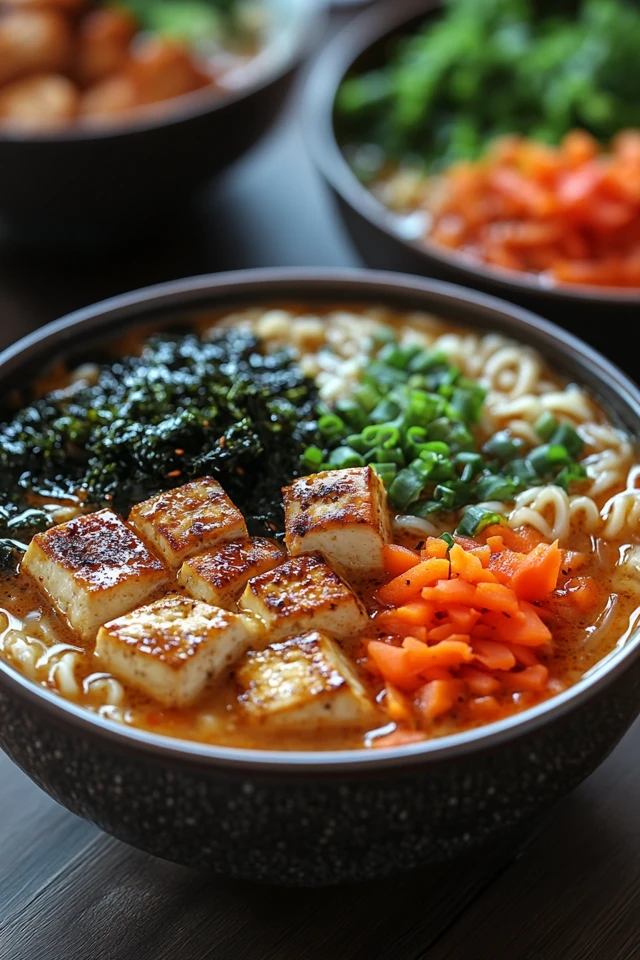
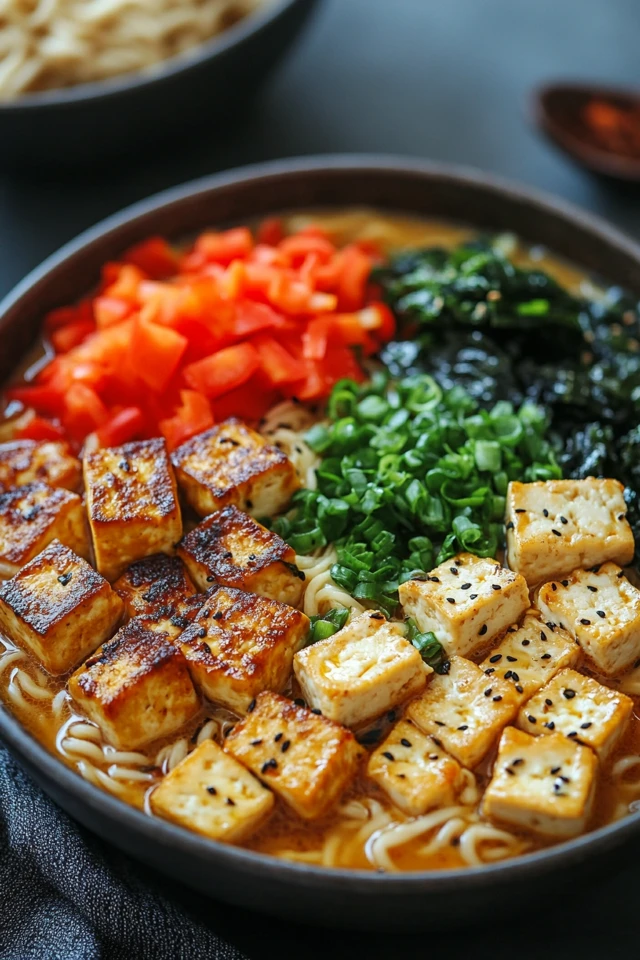
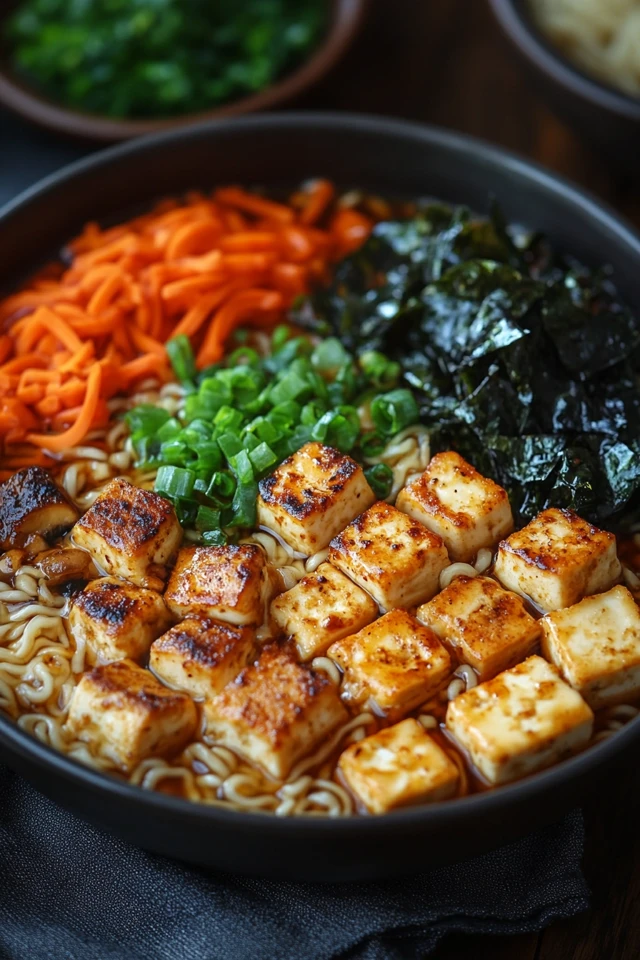
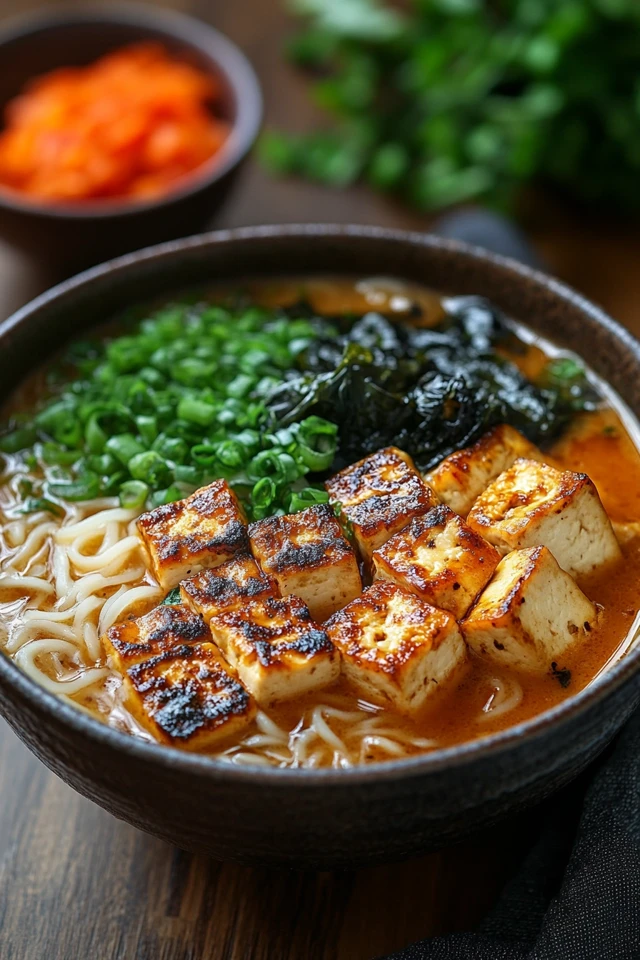
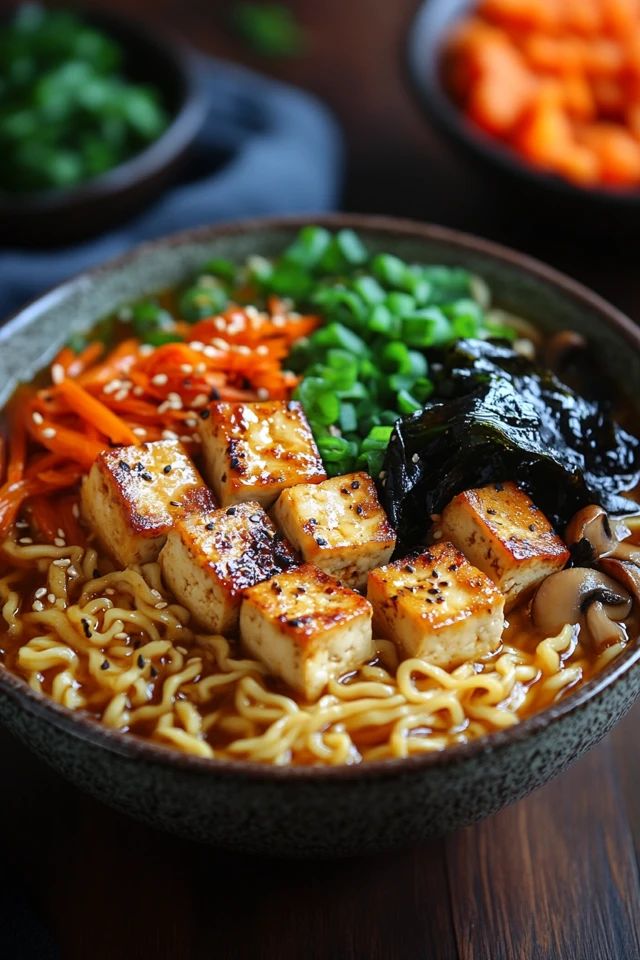
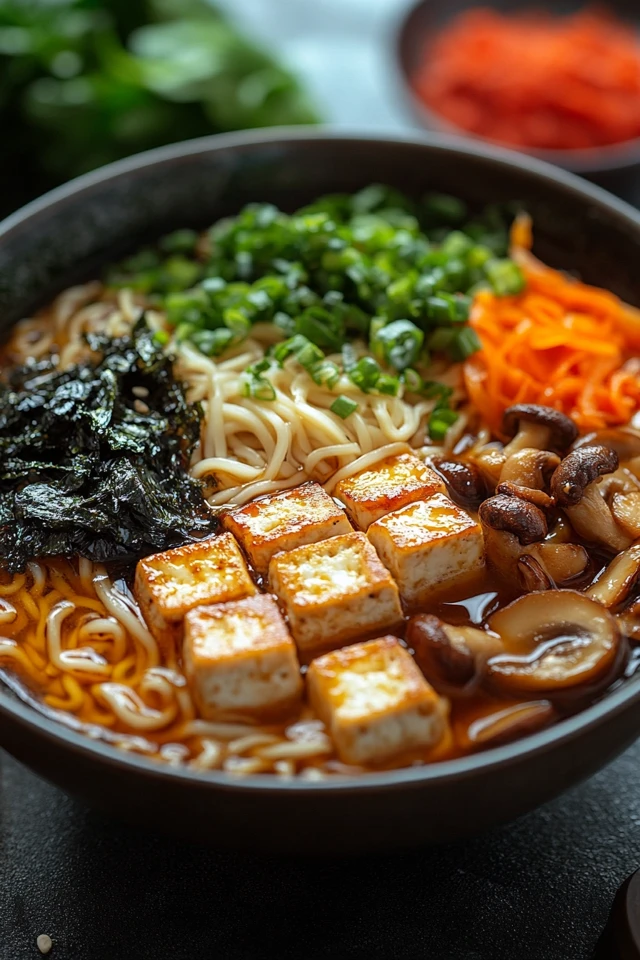
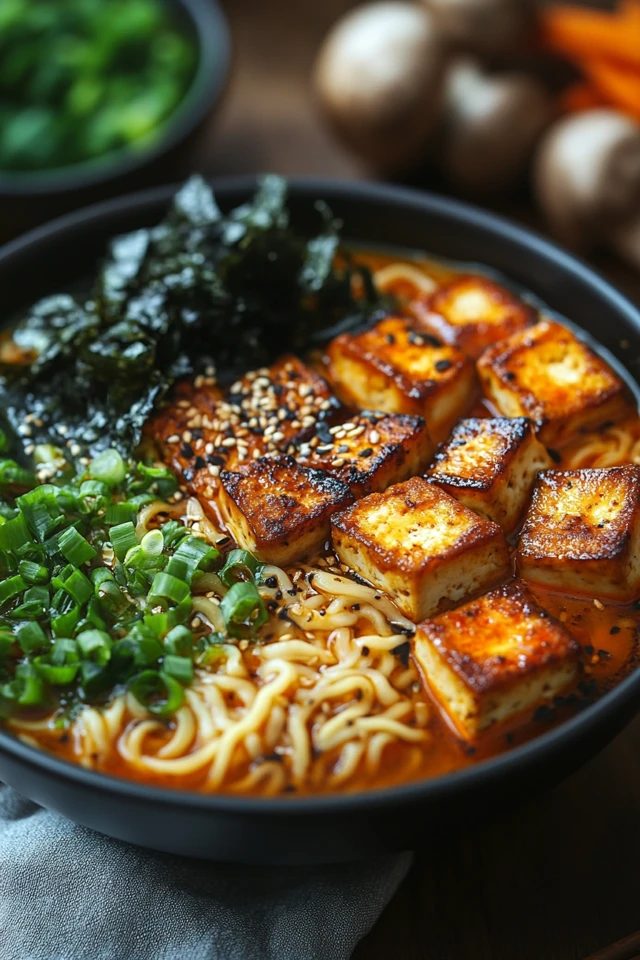
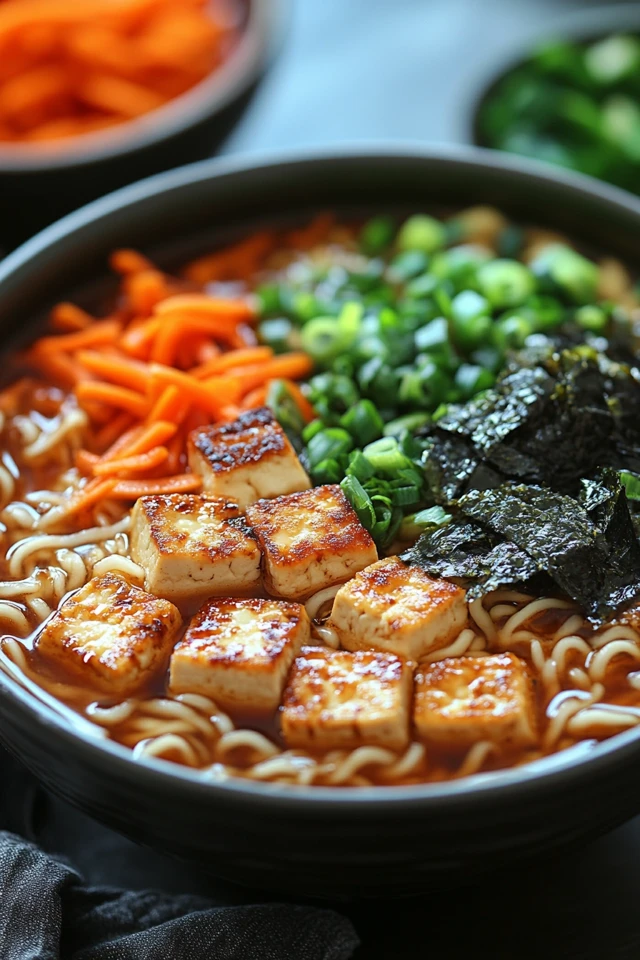
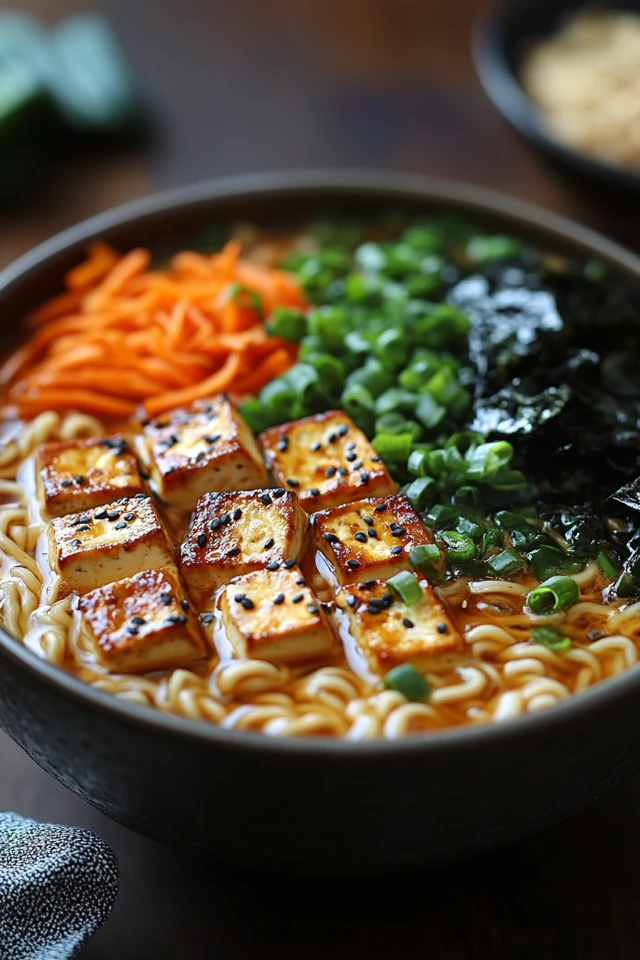
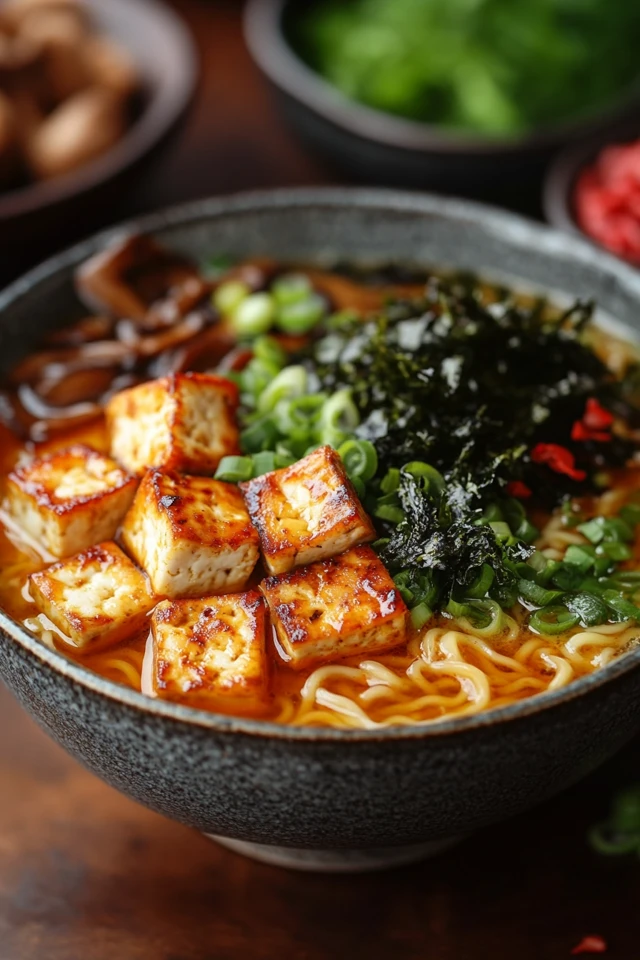
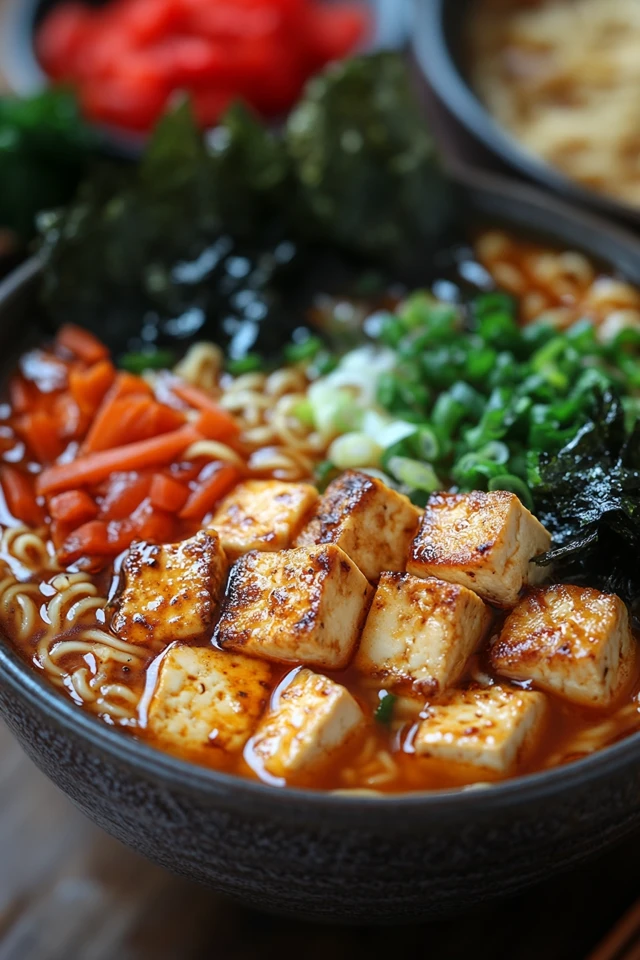
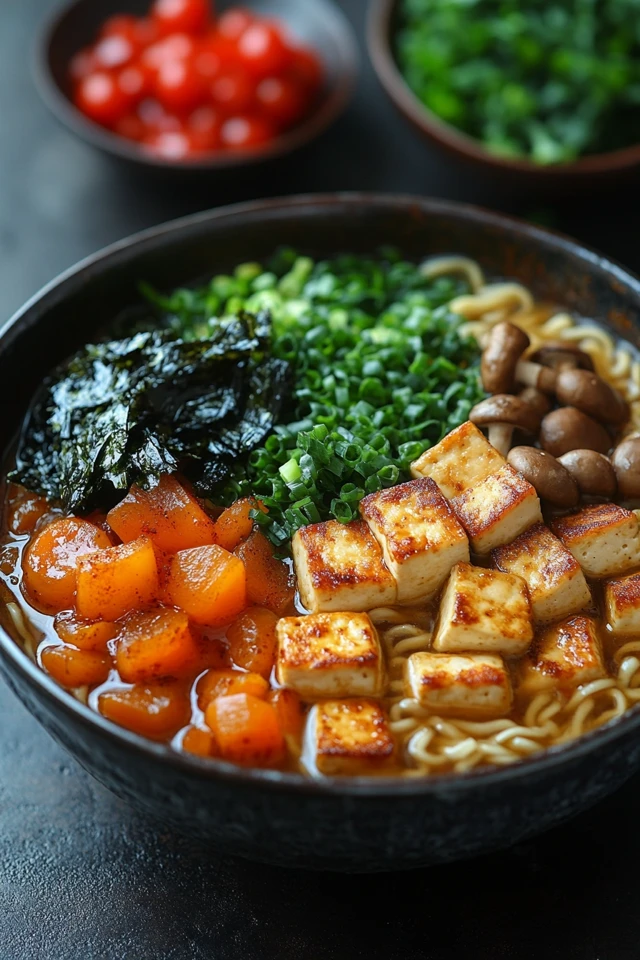
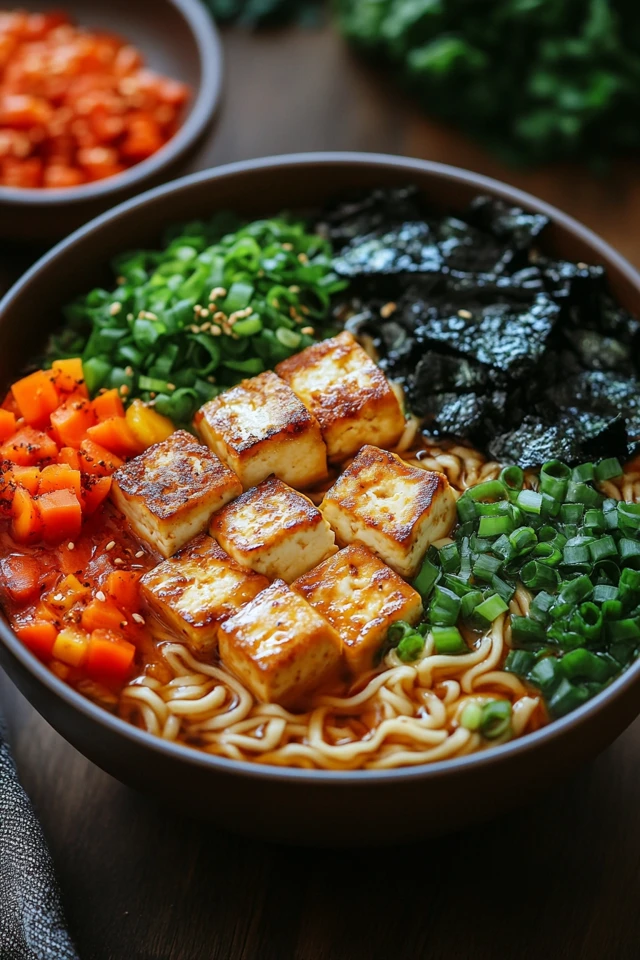

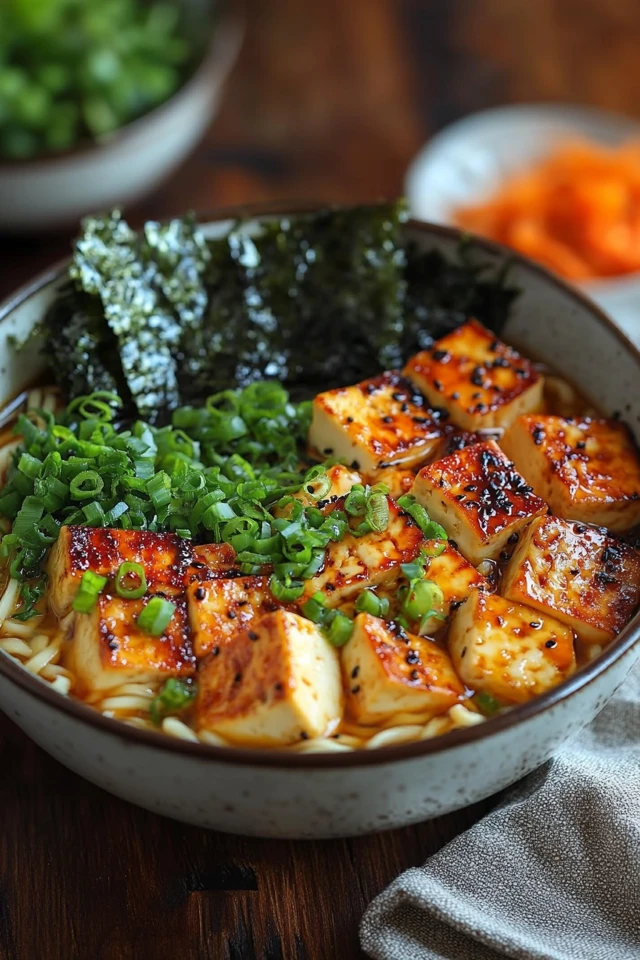
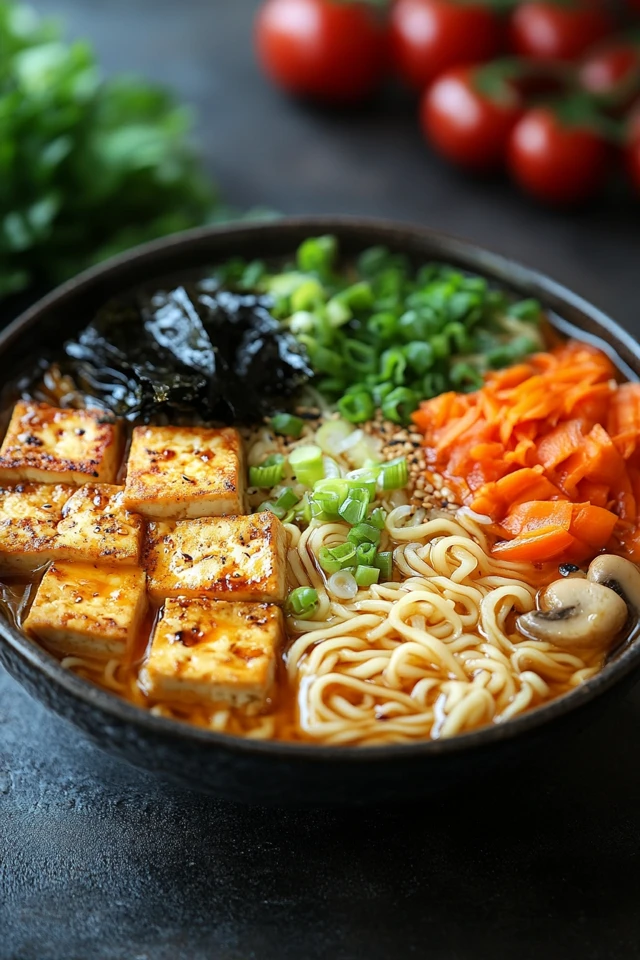
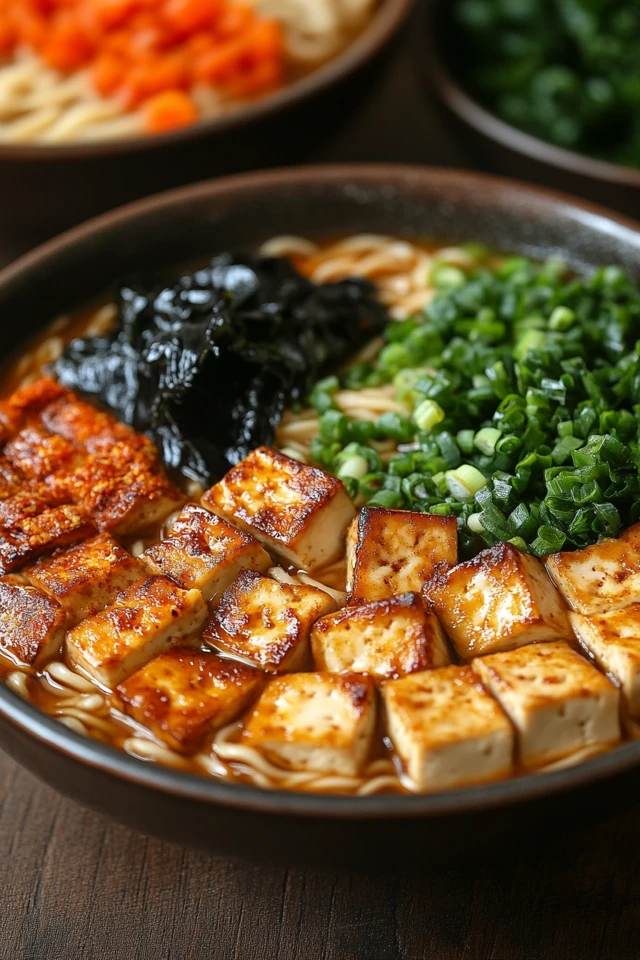
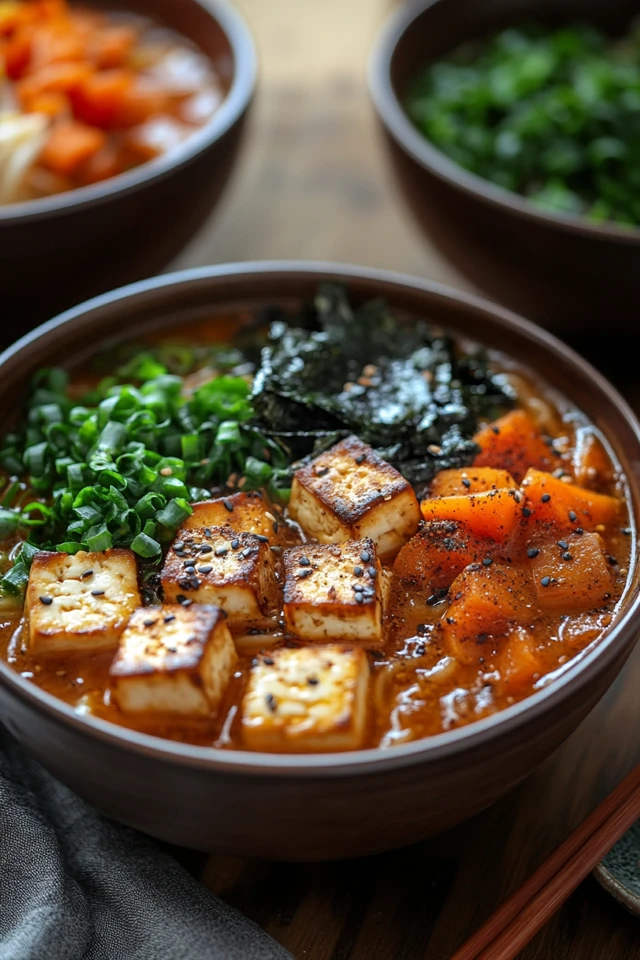
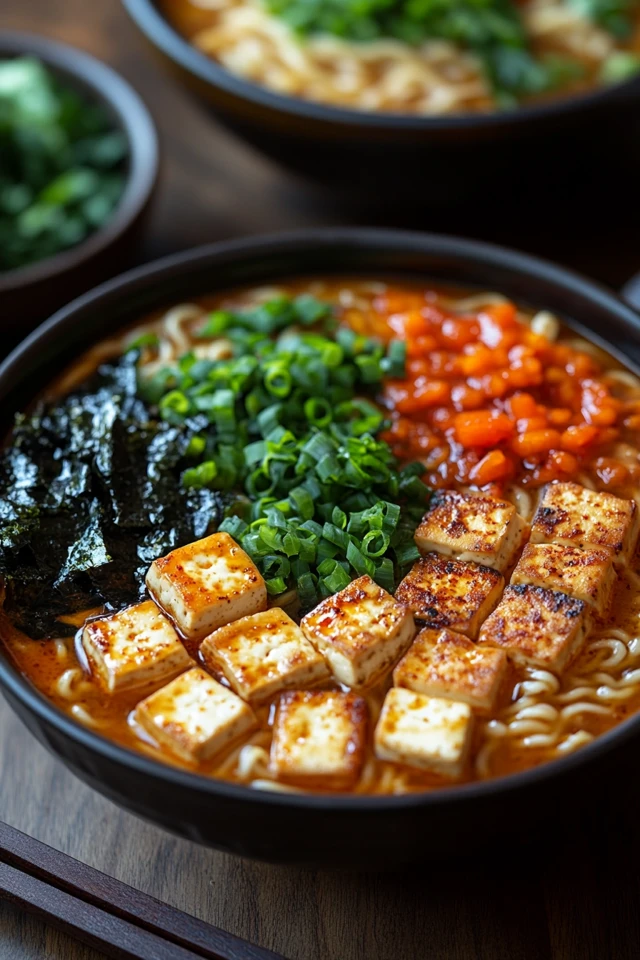
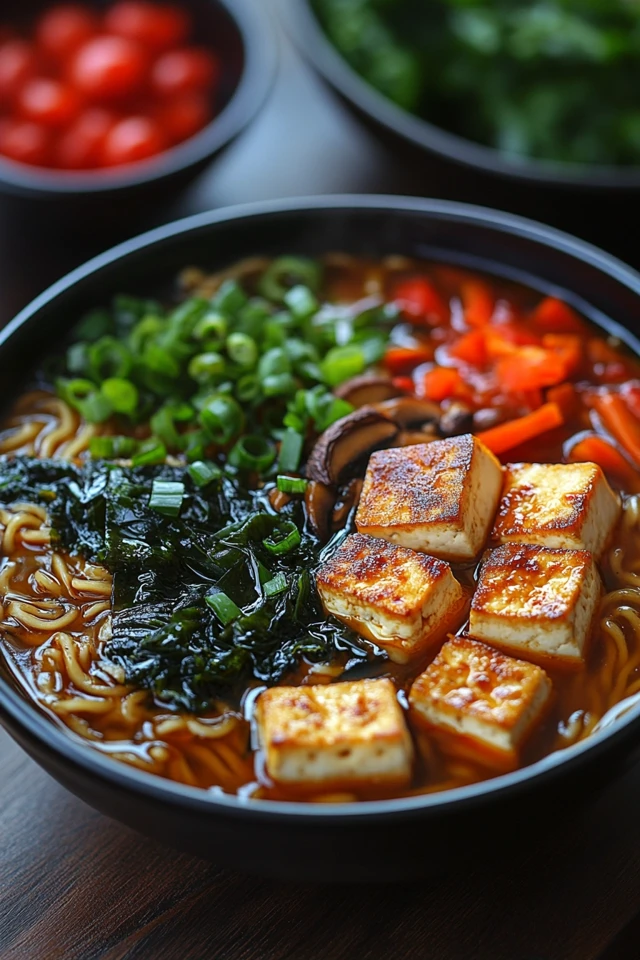

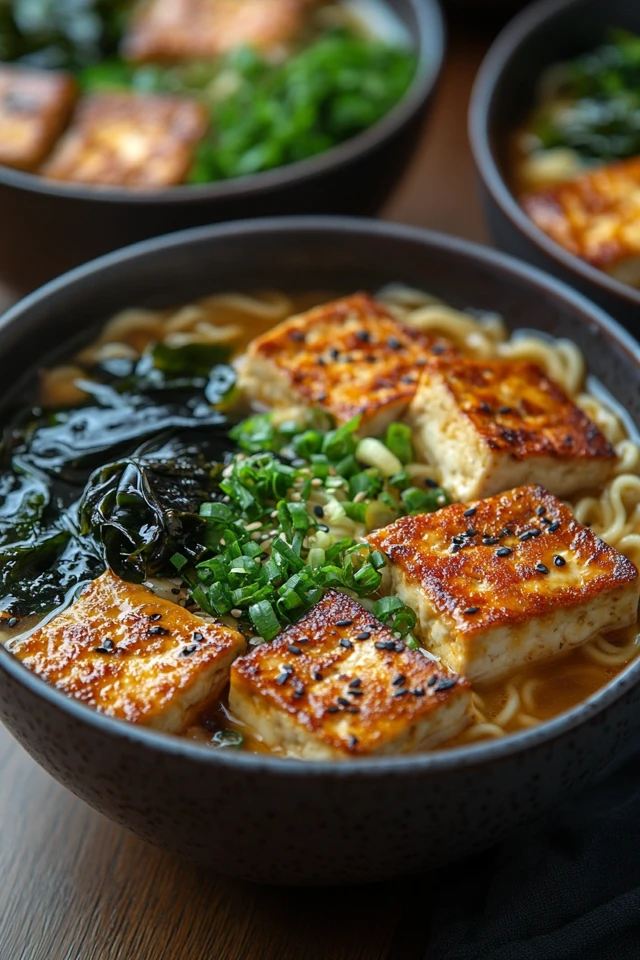
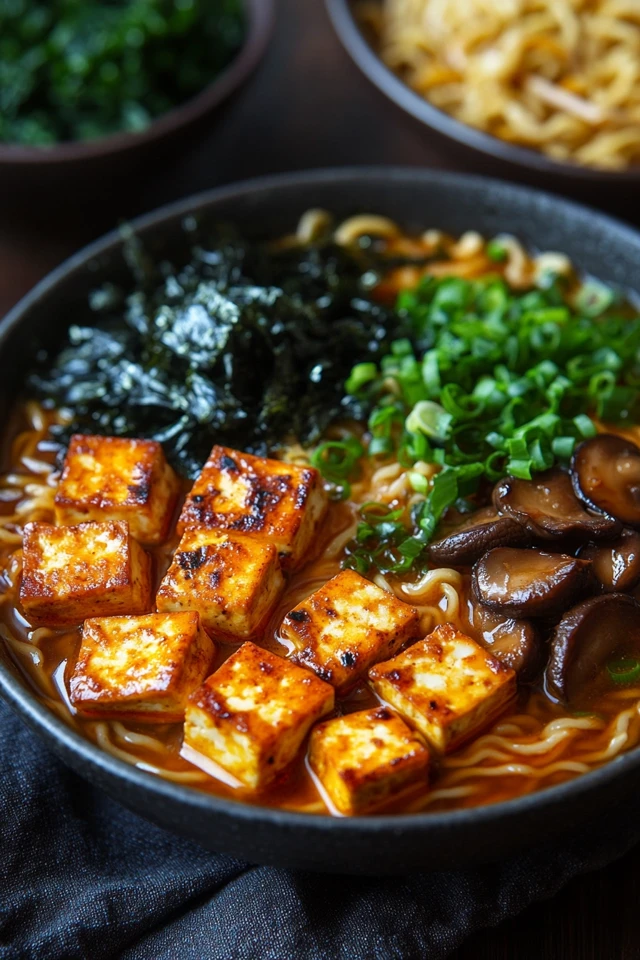
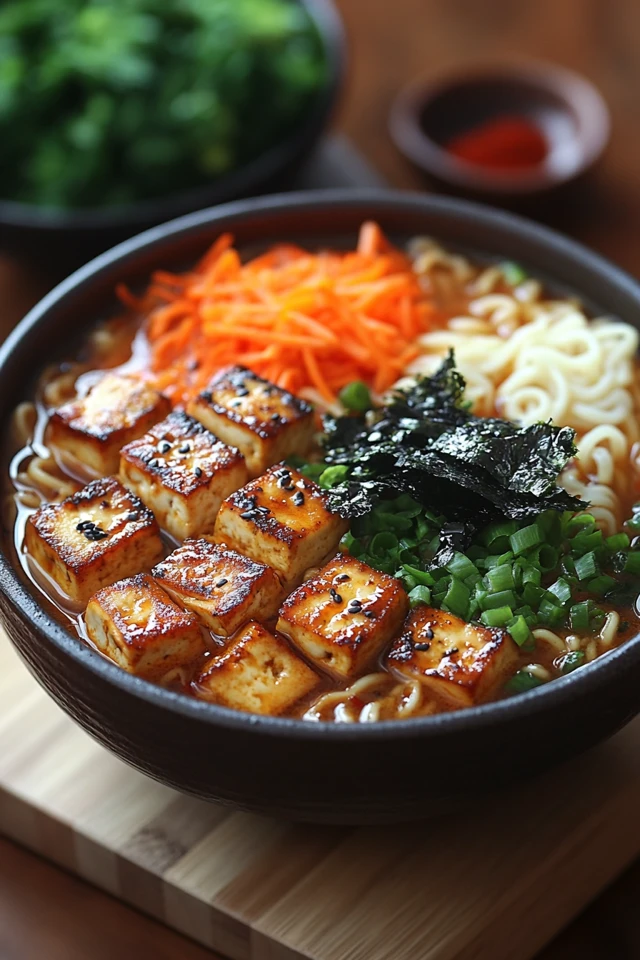
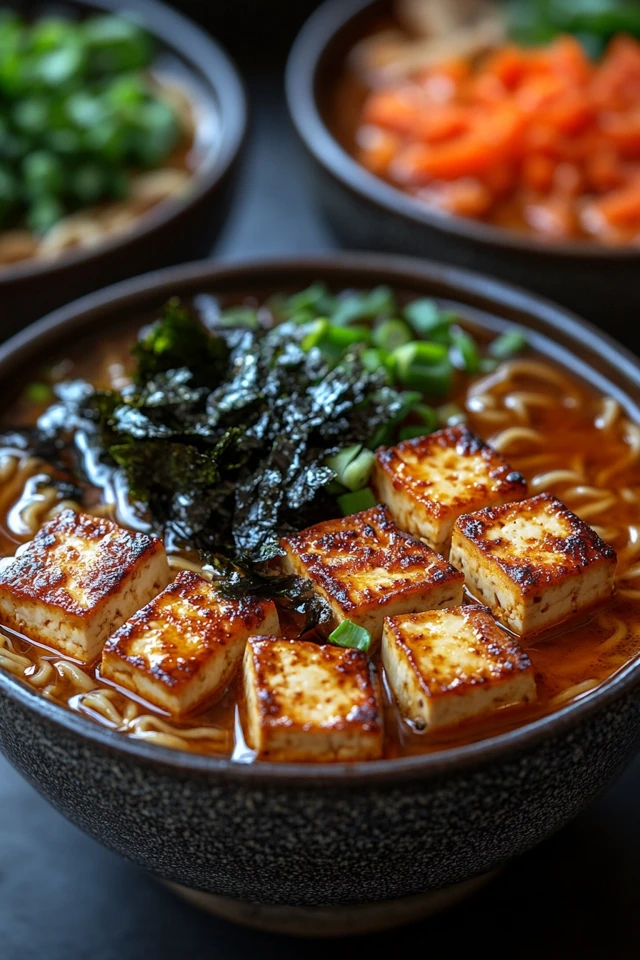
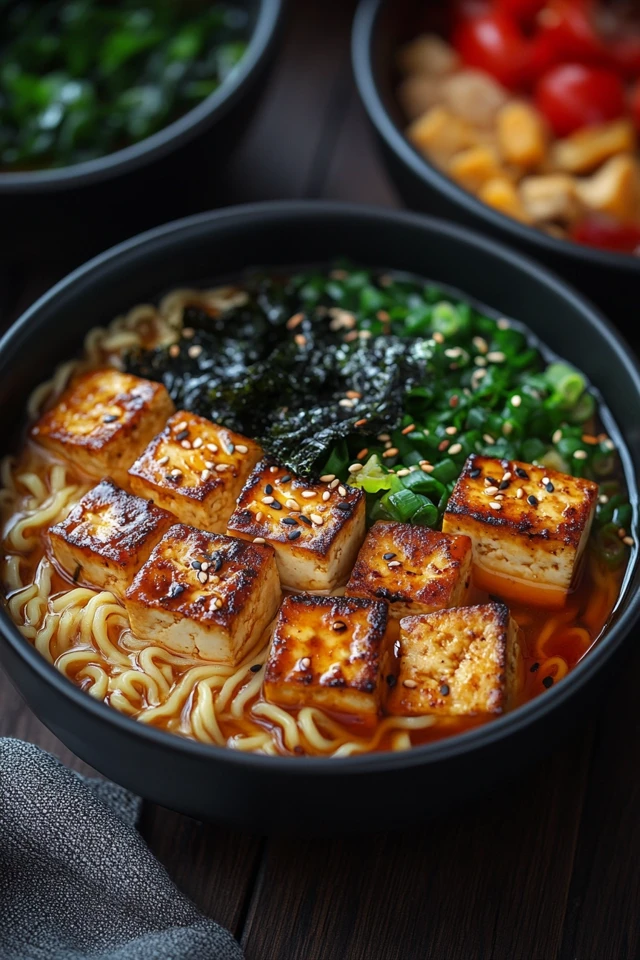
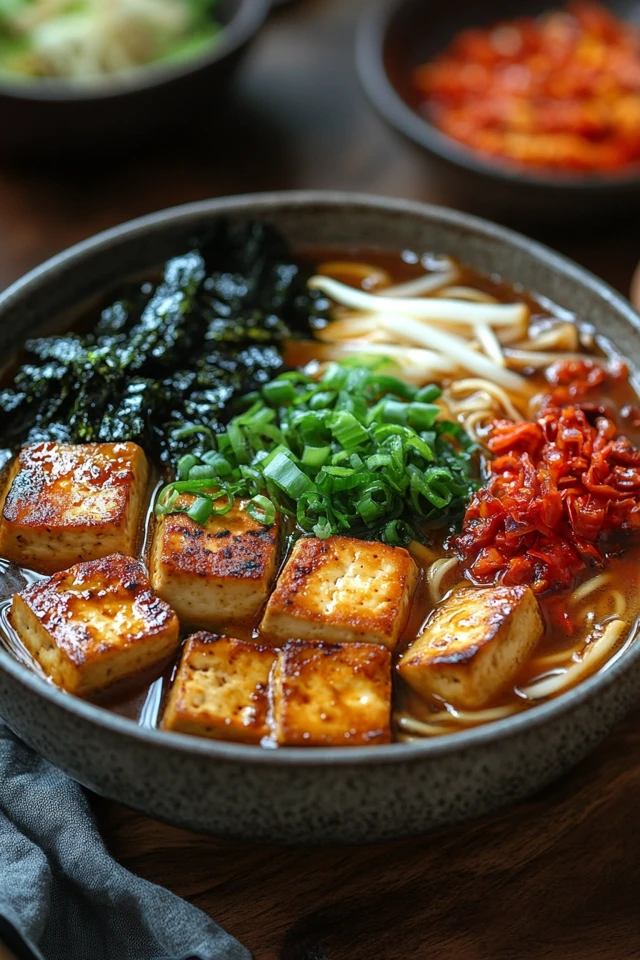
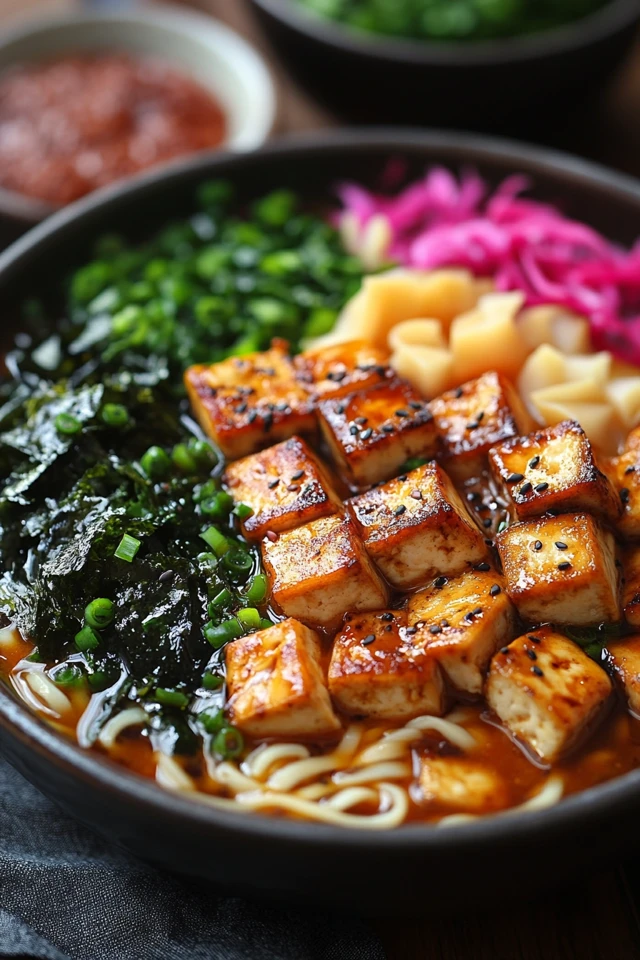
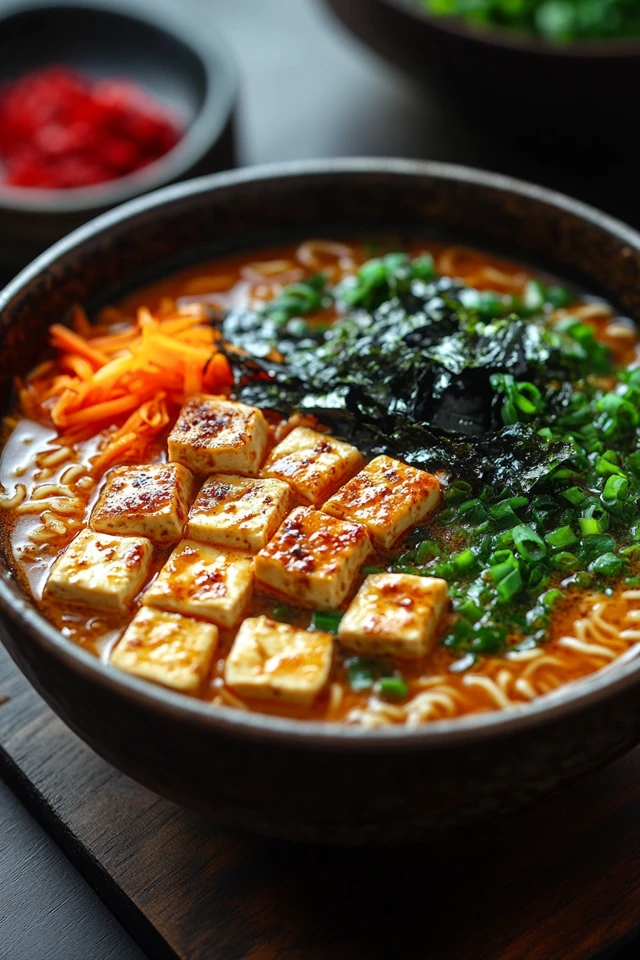
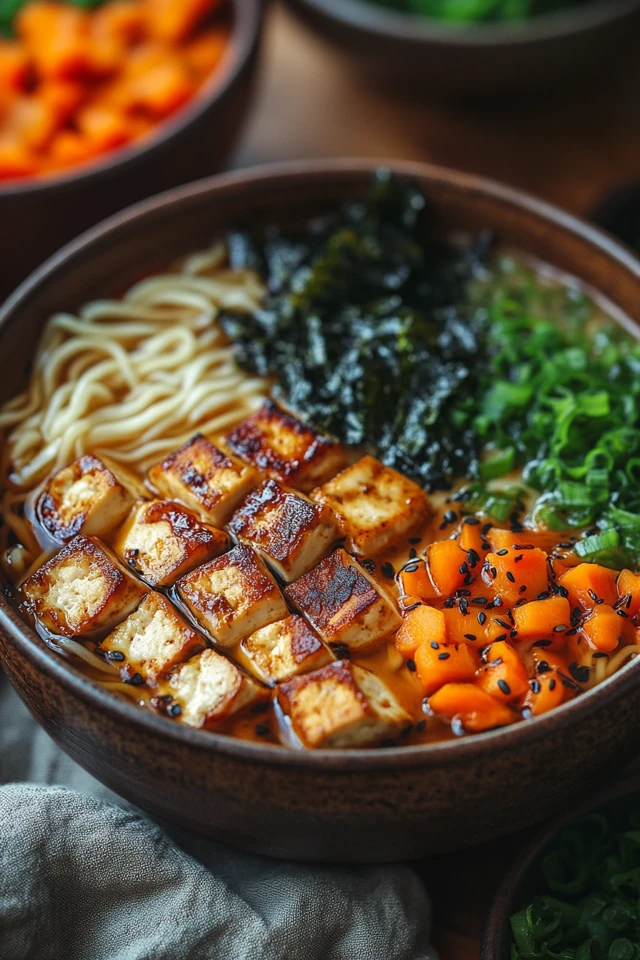
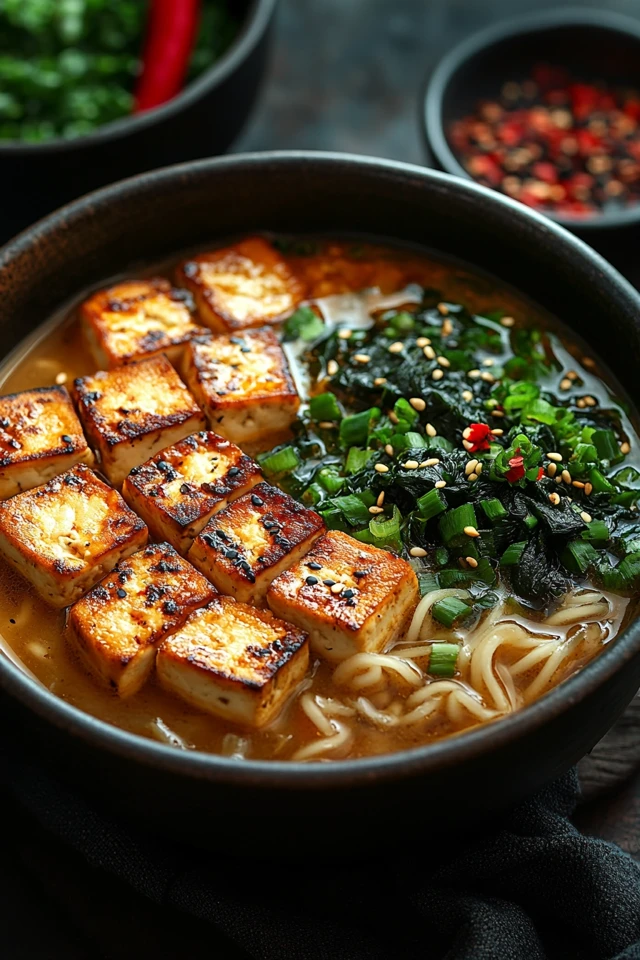
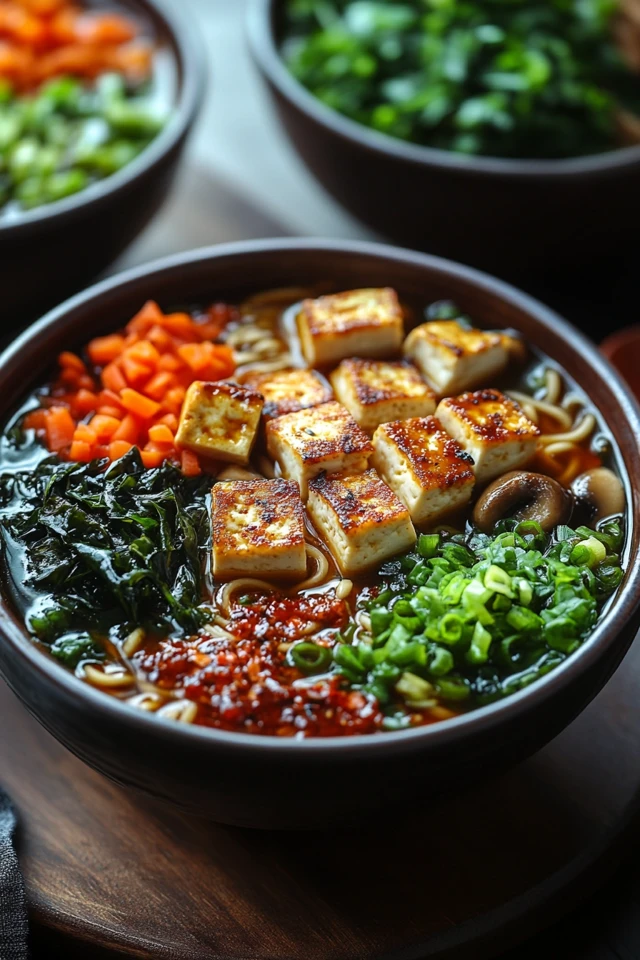
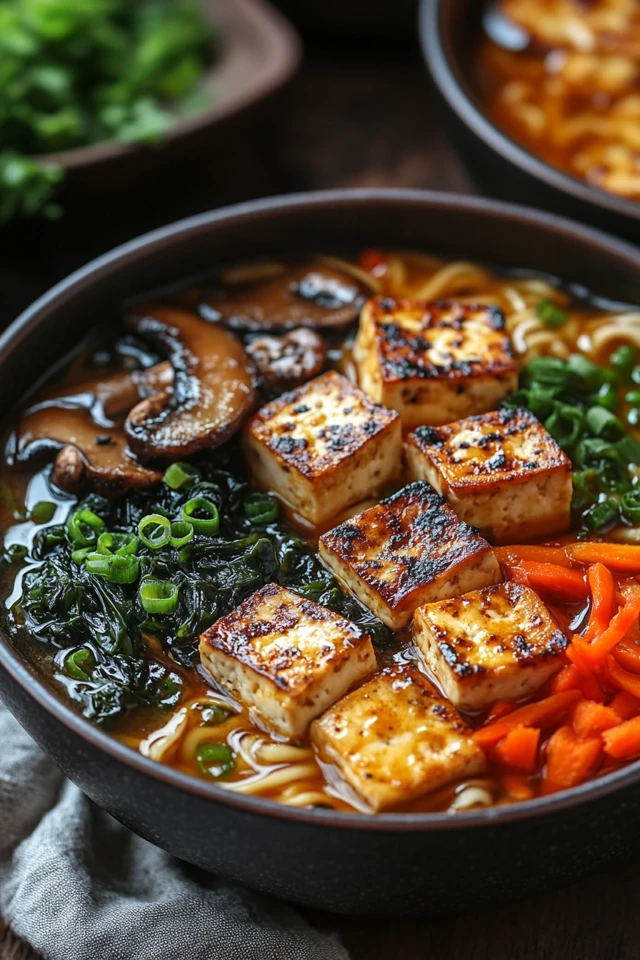
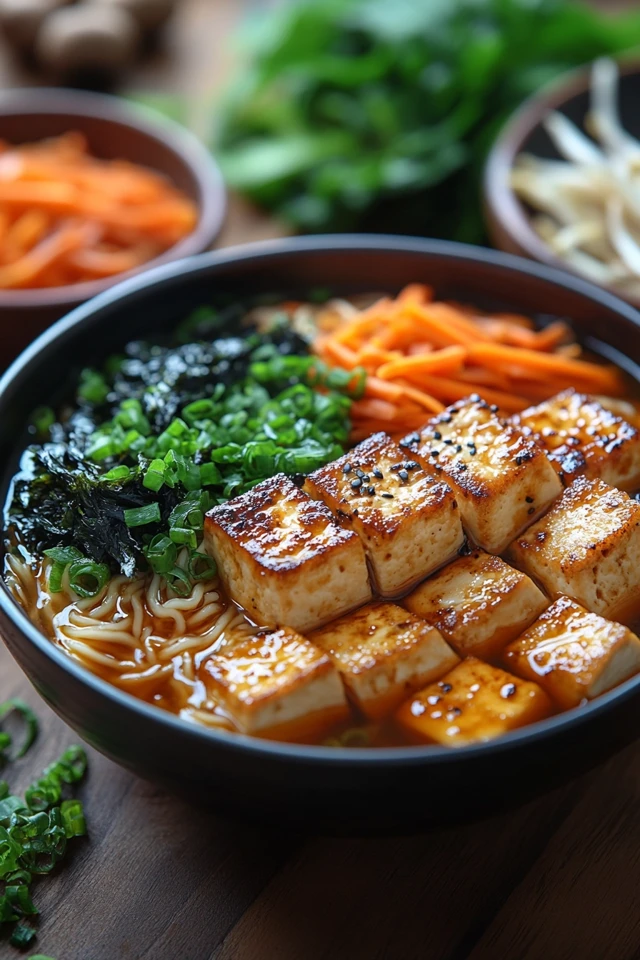
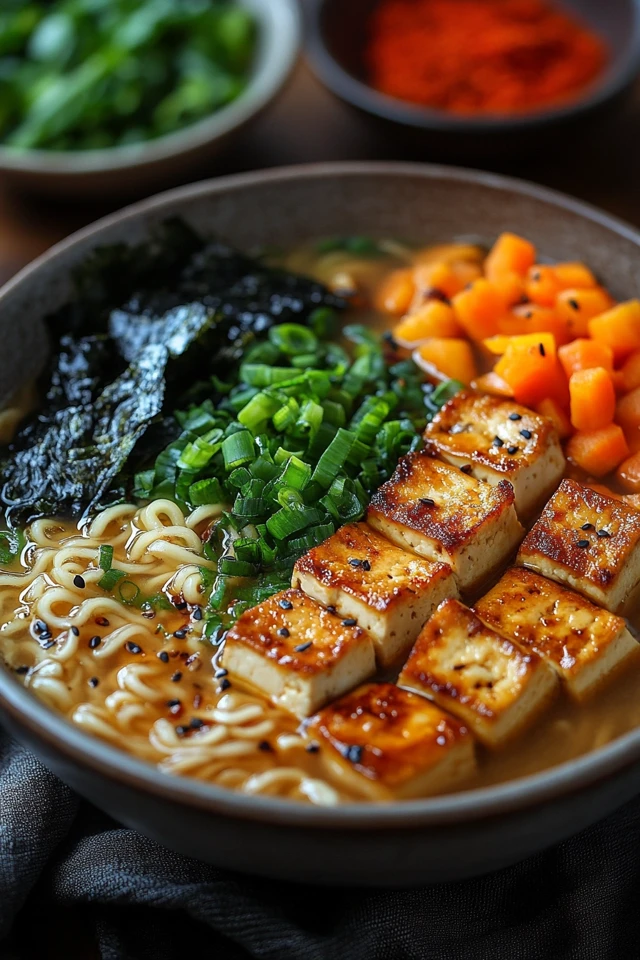
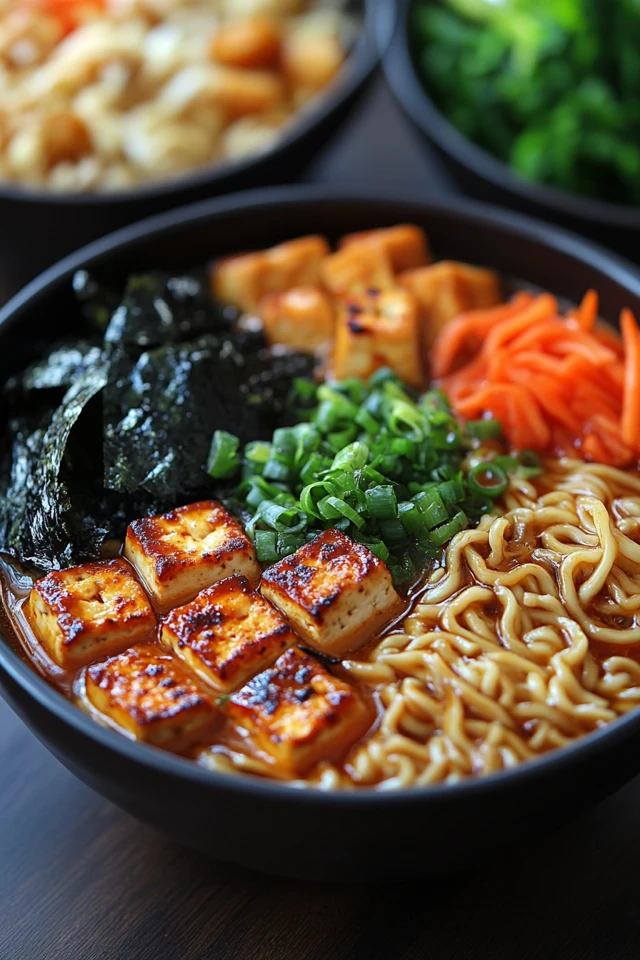
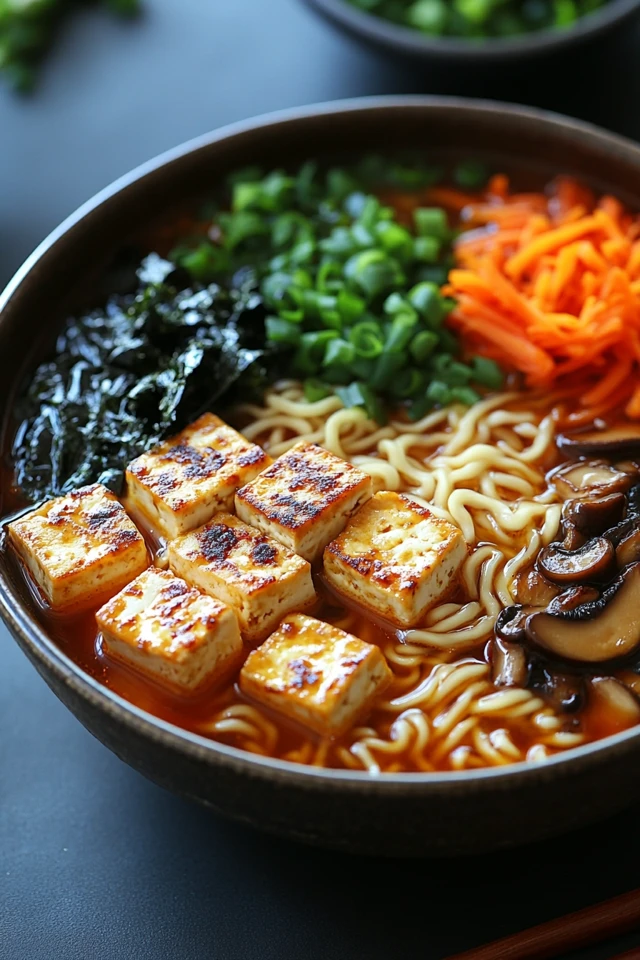
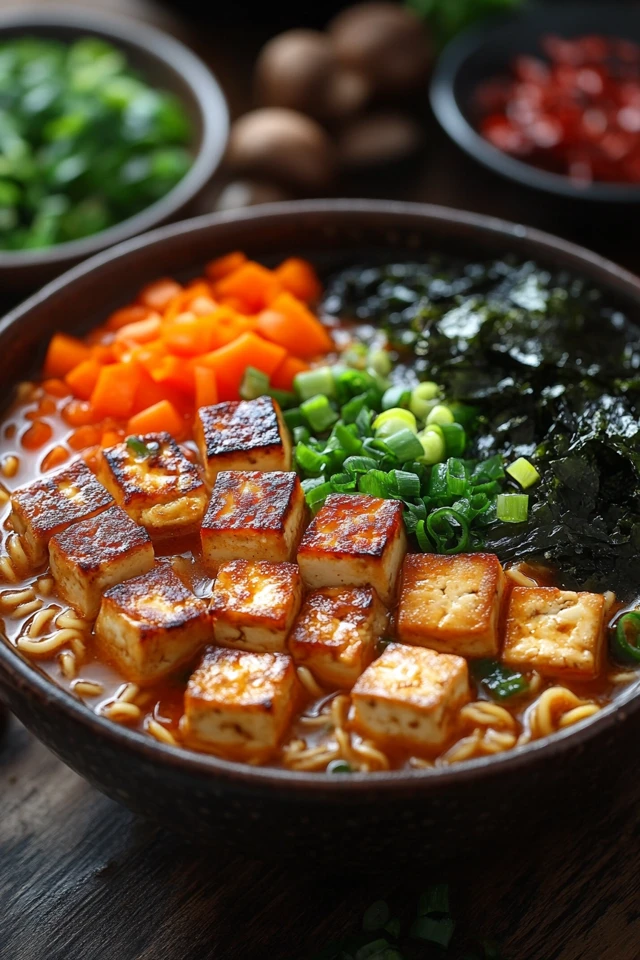
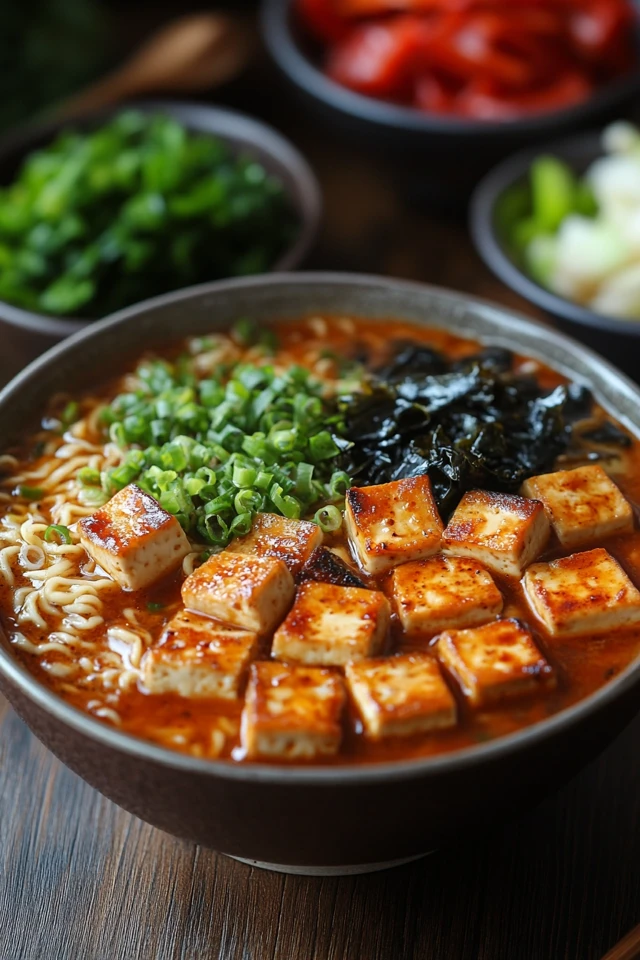
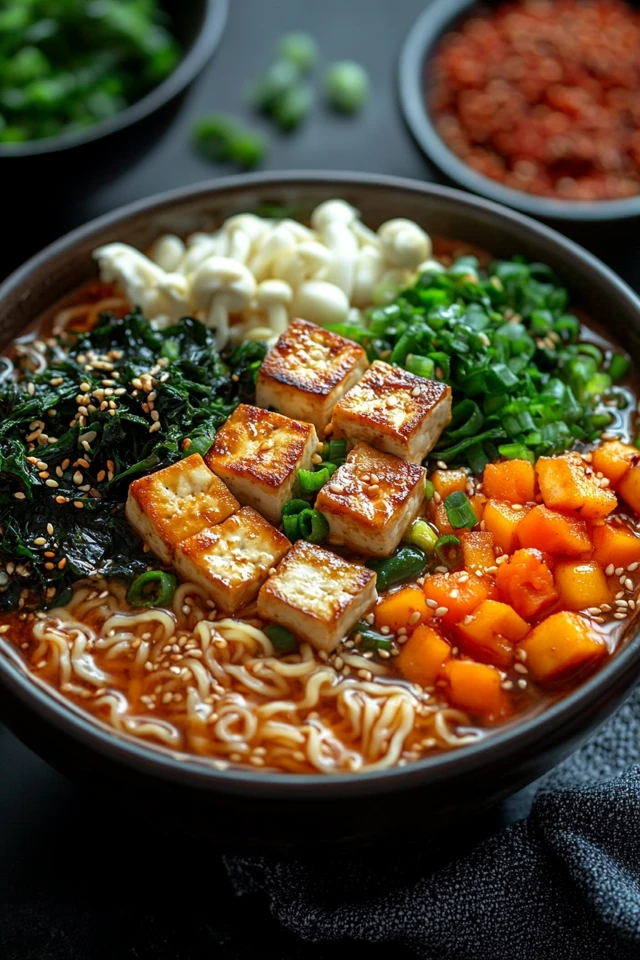
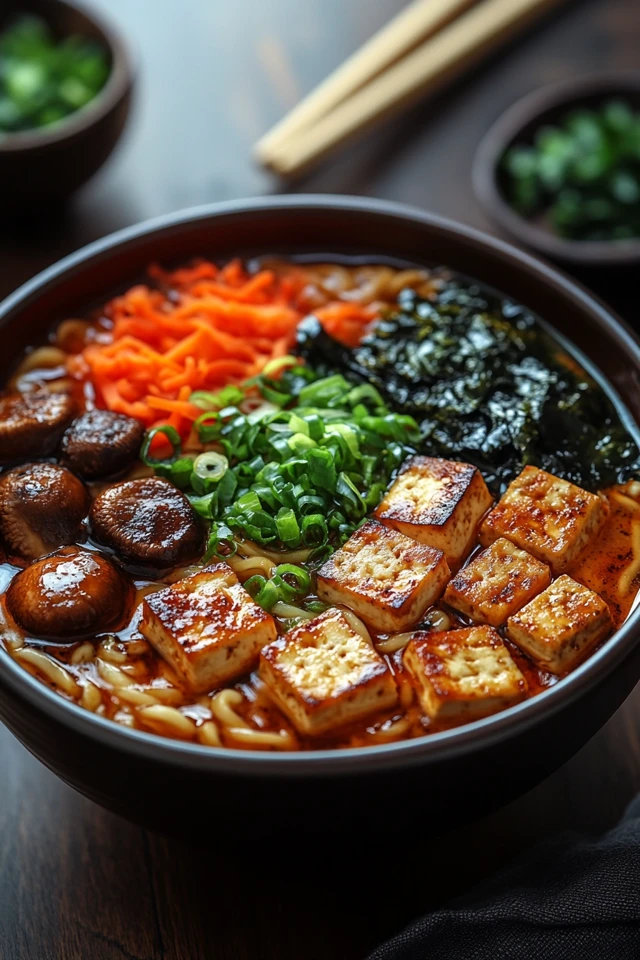
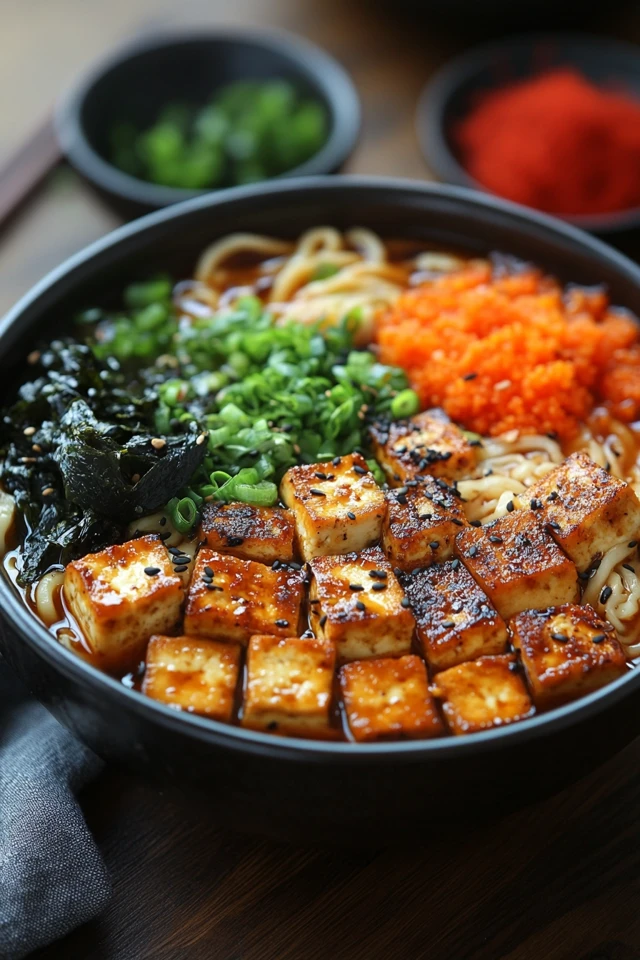
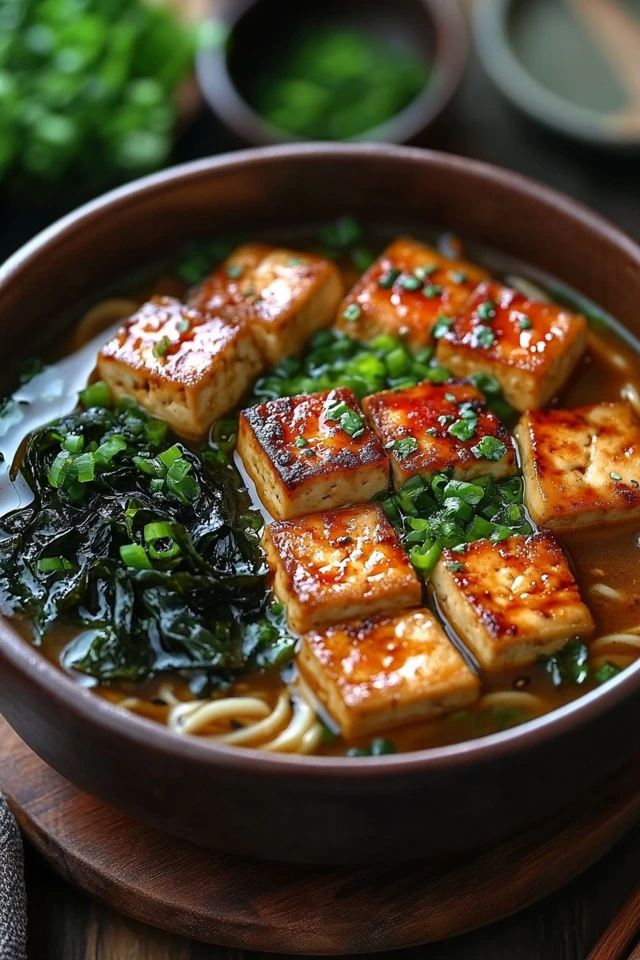
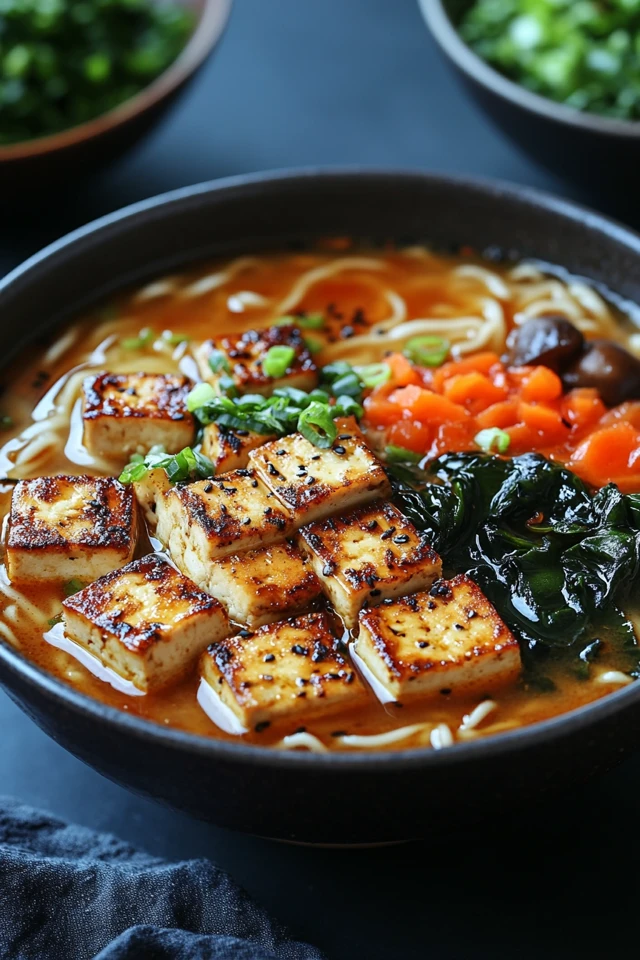
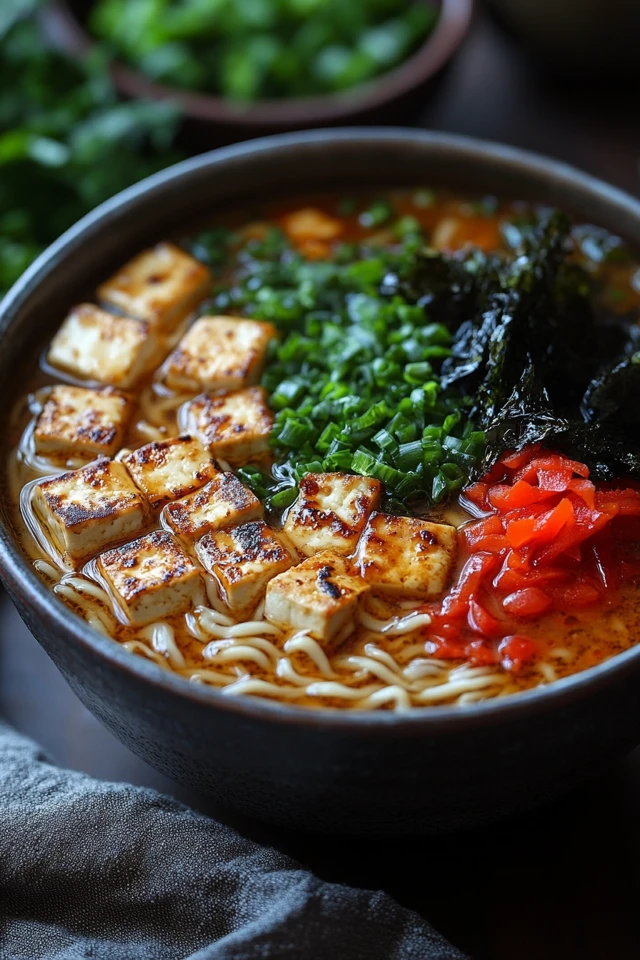
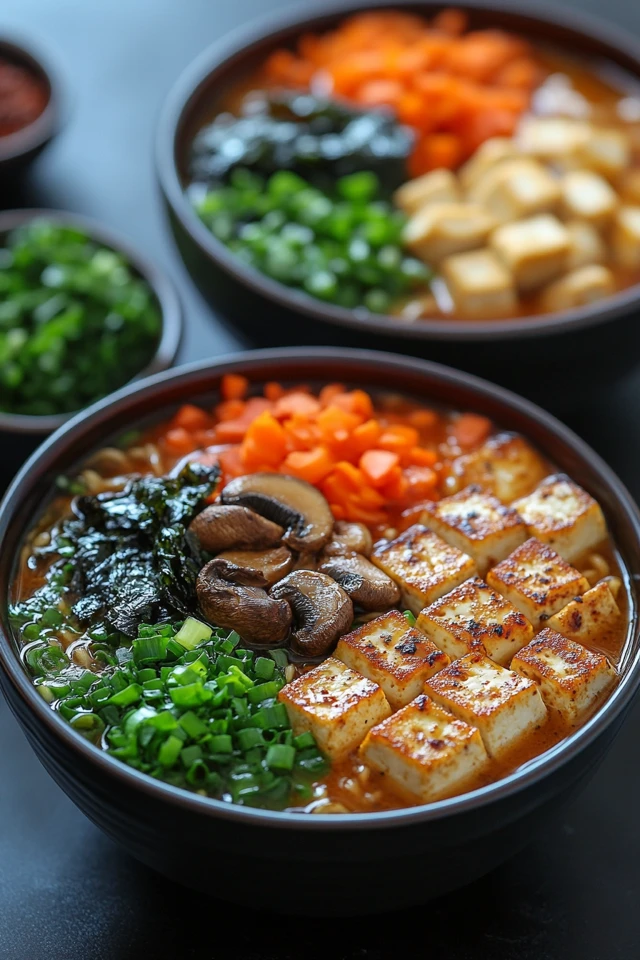
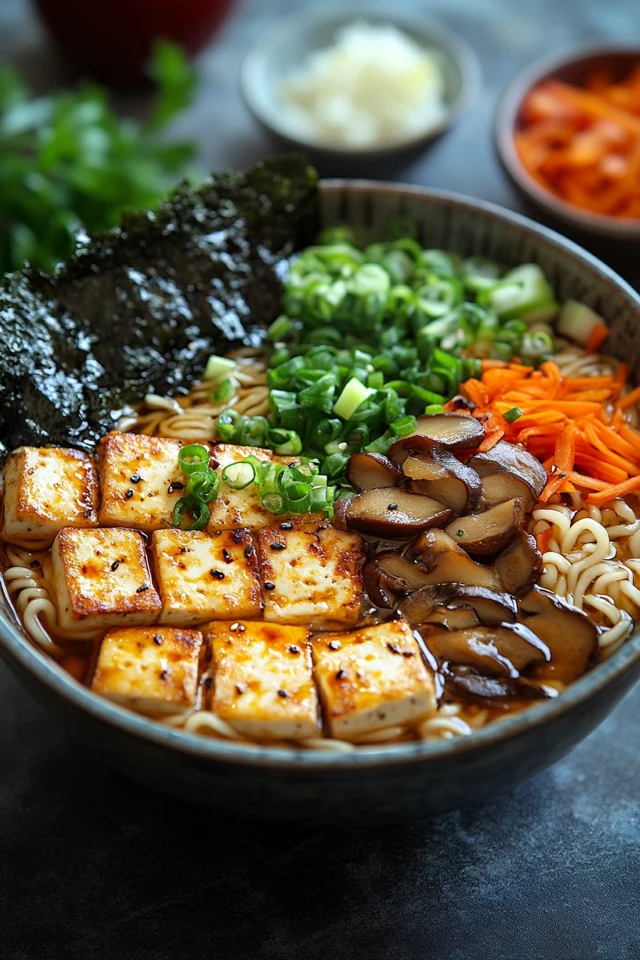
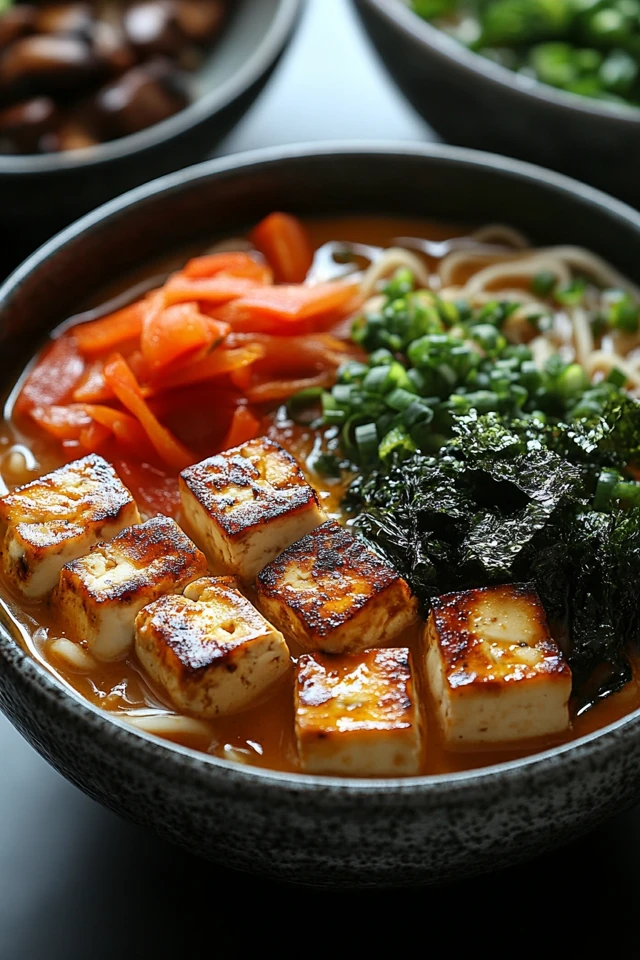
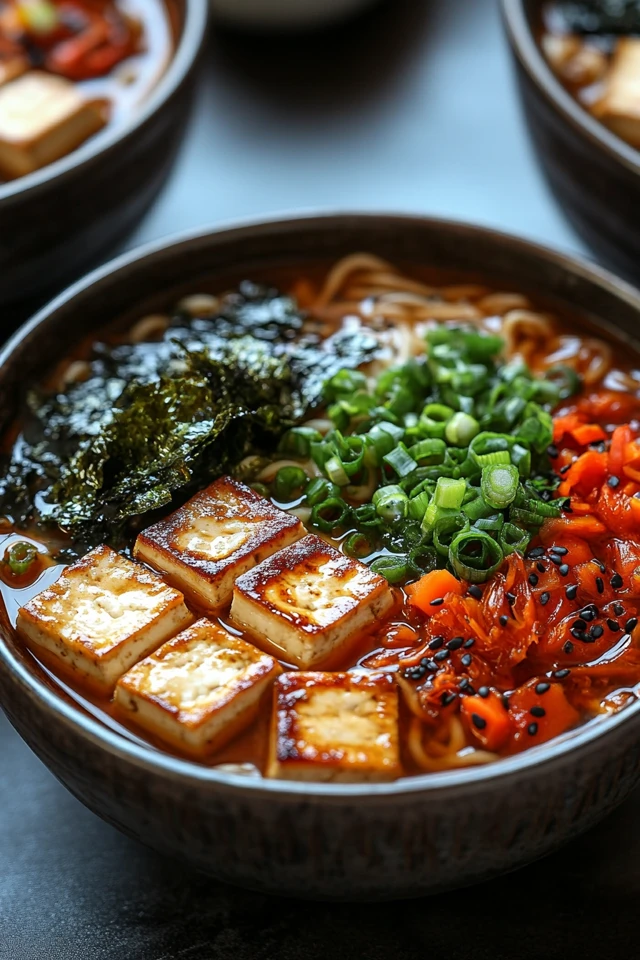
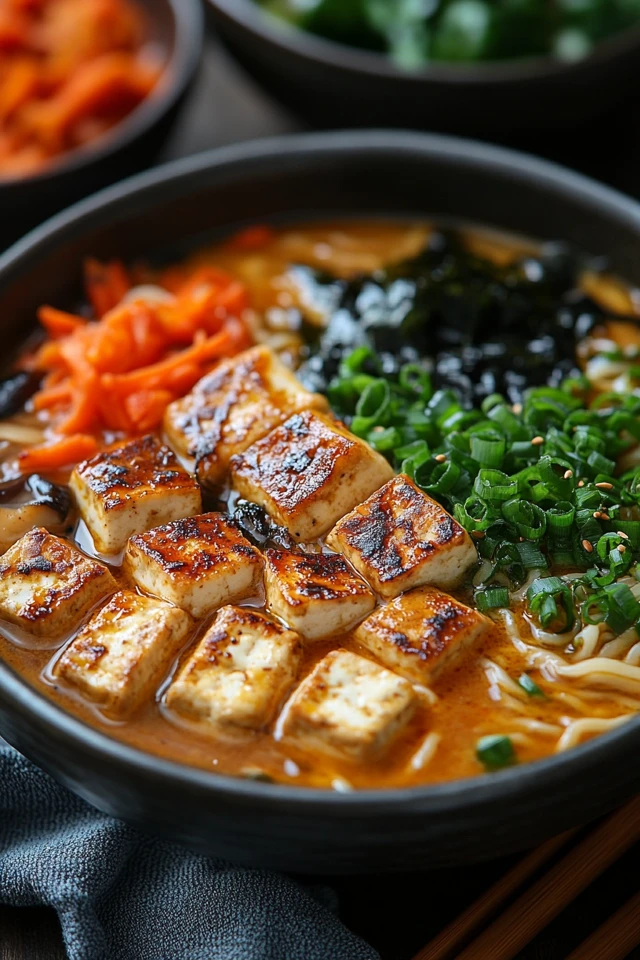
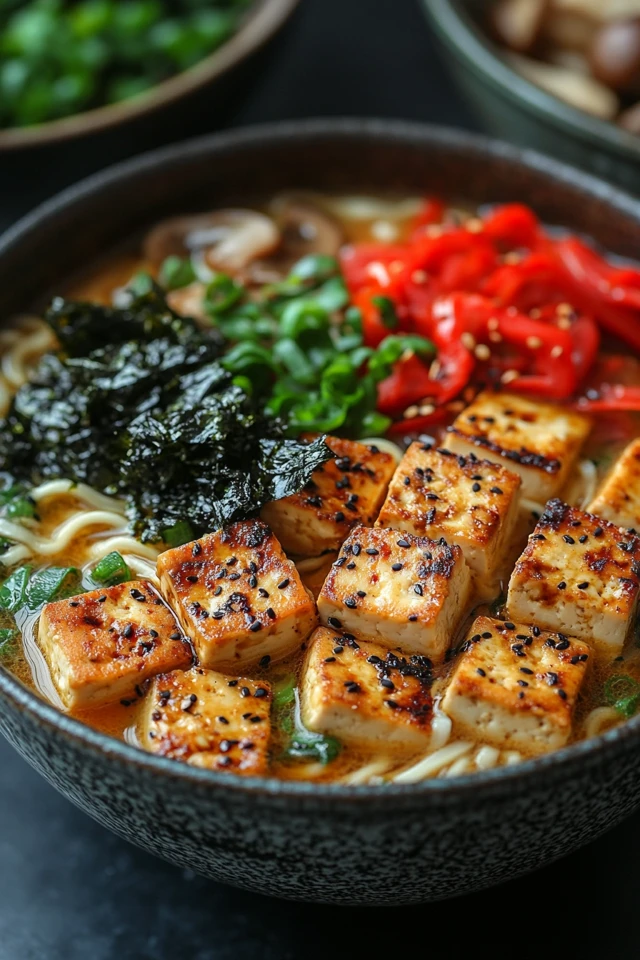
Frequently Asked Questions (FAQs)
1. Can I make the broth ahead of time?
Absolutely! Japanese Vegan Ramen broth can be made up to 3 days in advance. Store it in an airtight container in the refrigerator. Reheat gently on the stovetop before serving, adding a splash of water or vegetable broth if the curry has thickened too much.
2. What can I use as a plant-based protein substitute?
You can use tofu, tempeh, seitan, or even chickpeas as a plant-based protein substitute. Each option offers a different texture and flavor, so choose based on your preference:
- Tofu: Provides a firm and versatile protein that absorbs flavors well.
- Tempeh: Offers a nuttier flavor and firmer texture.
- Seitan: Delivers a chewy and hearty texture similar to traditional meat.
- Chickpeas: Adds a slightly nutty flavor and creamy texture.
3. Is this recipe gluten-free?
Yes! By using tamari instead of regular soy sauce and ensuring that all other ingredients, including the ramen noodles, are gluten-free, you can easily make this dish gluten-free. Always check labels to confirm the gluten-free status of store-bought products.
4. How can I make the broth more flavorful?
To make the broth more flavorful, consider adding ingredients like kombu (dried kelp) or shiitake mushroom stems during the simmering process for added umami. You can also incorporate a splash of mirin or sake for depth.
5. Can I add more vegetables to the ramen?
Absolutely! Feel free to incorporate additional vegetables like broccoli, mushrooms, bok choy, or sweet potatoes to increase the nutritional value and add more texture to your ramen.
6. How do I prevent the noodles from sticking together?
To prevent noodles from sticking, ensure you use plenty of boiling water and add a pinch of salt to the water. Stir the noodles occasionally during cooking. Rinse them briefly under cold water after draining if not serving immediately.
7. Can I use different types of noodles?
Yes! While traditional ramen noodles work best, you can use soba, udon, or even rice noodles as a substitute based on your preference and dietary needs.
8. How do I store leftovers?
Store any leftover ramen in an airtight container in the refrigerator for up to 3 days. Reheat the broth and noodles separately to maintain texture, adding a splash of water or broth as needed.
9. Can I make a spicy version of this ramen?
Absolutely! Add a tablespoon of chili paste, a few slices of fresh jalapeño, or a drizzle of sriracha to the broth for an extra spicy kick. Adjust the amount based on your heat preference.
10. What can I serve alongside this vegan ramen?
Serve your Japanese Vegan Ramen alongside other Japanese-inspired dishes like vegan gyoza, edamame, seaweed salad, or a fresh green salad for a well-rounded meal. They also pair wonderfully with a side of pickled vegetables for added tang.
About the Author
Welcome to Vegan & Plant-Based Kitchen! I’m Julio Arco, a passionate vegan chef dedicated to creating delicious, easy-to-make plant-based recipes that nourish both body and soul. Since embracing a vegan lifestyle in 2010, I’ve been on a culinary journey to explore the endless possibilities of plant-based cooking. From vibrant salads to hearty mains and indulgent desserts, my mission is to inspire and empower you to embrace a compassionate and healthy lifestyle through wholesome food.
Join me on this journey as we explore diverse flavors, experiment with fresh ingredients, and celebrate the beauty of plant-based living. Let’s create, share, and enjoy the goodness of vegan cooking together!
Disclaimer: This blog post is intended for informational purposes only. Always consult with a healthcare professional before making significant changes to your diet.

